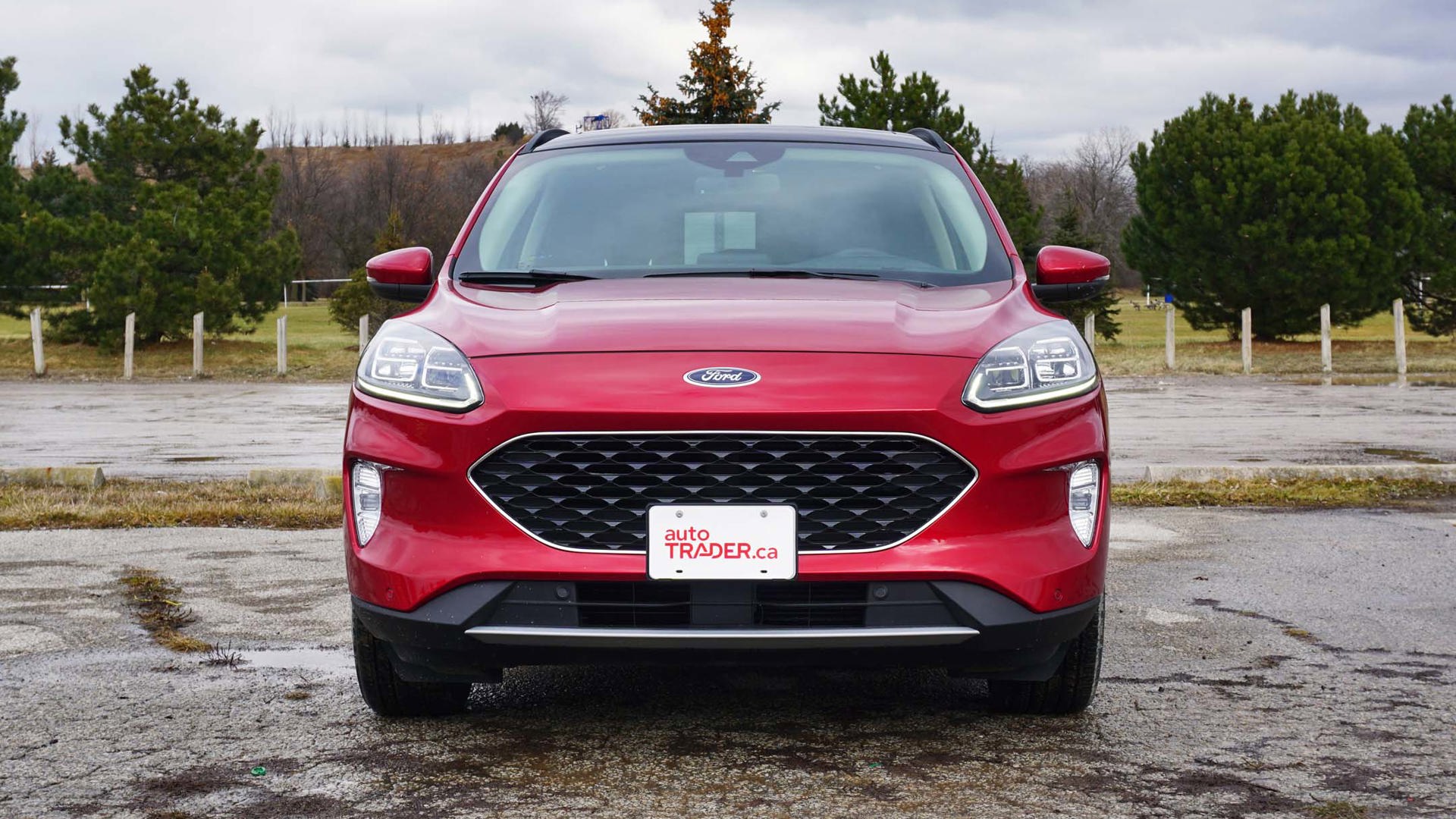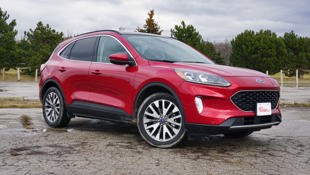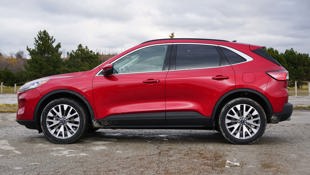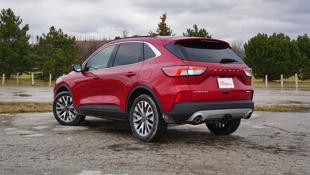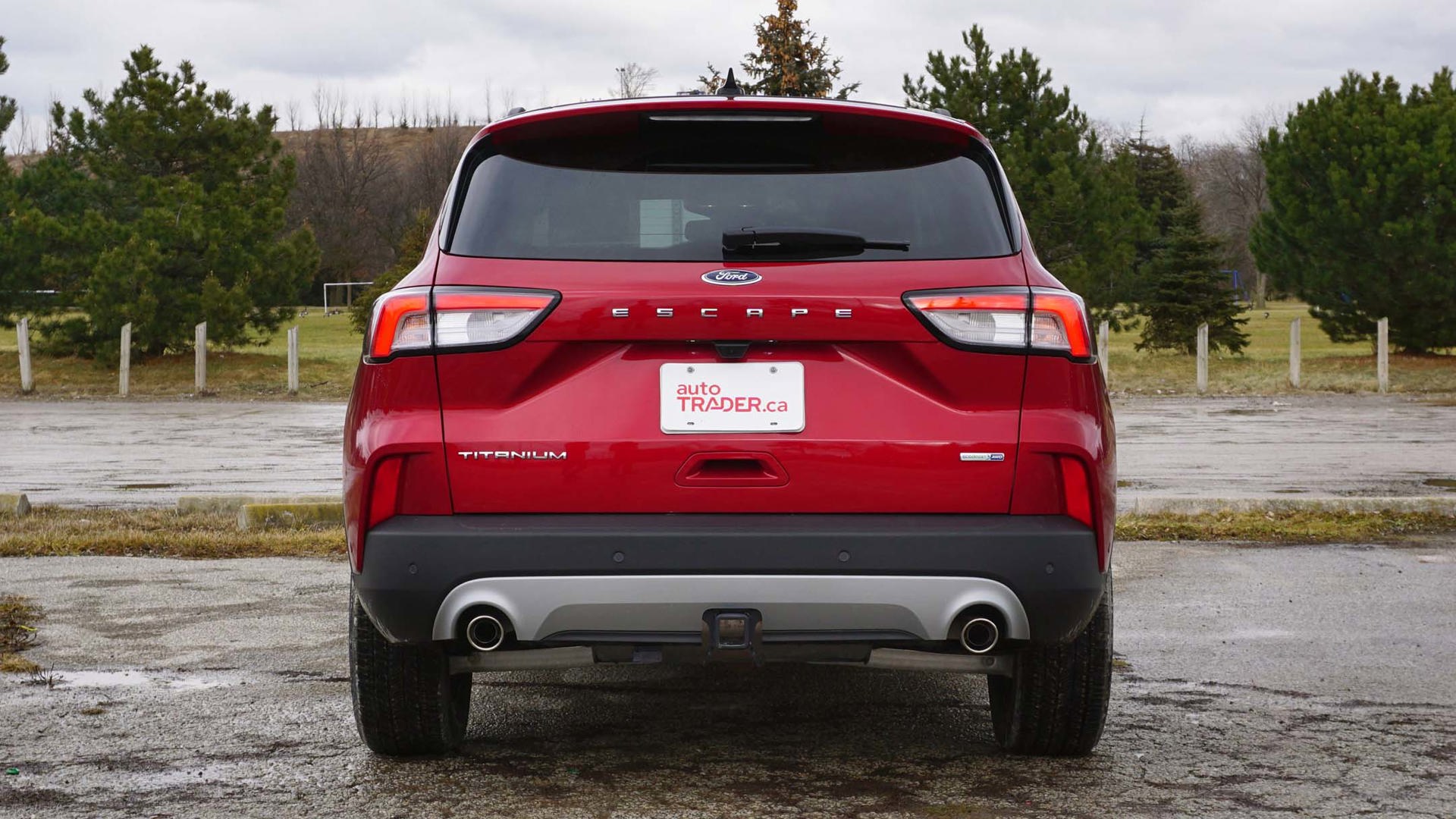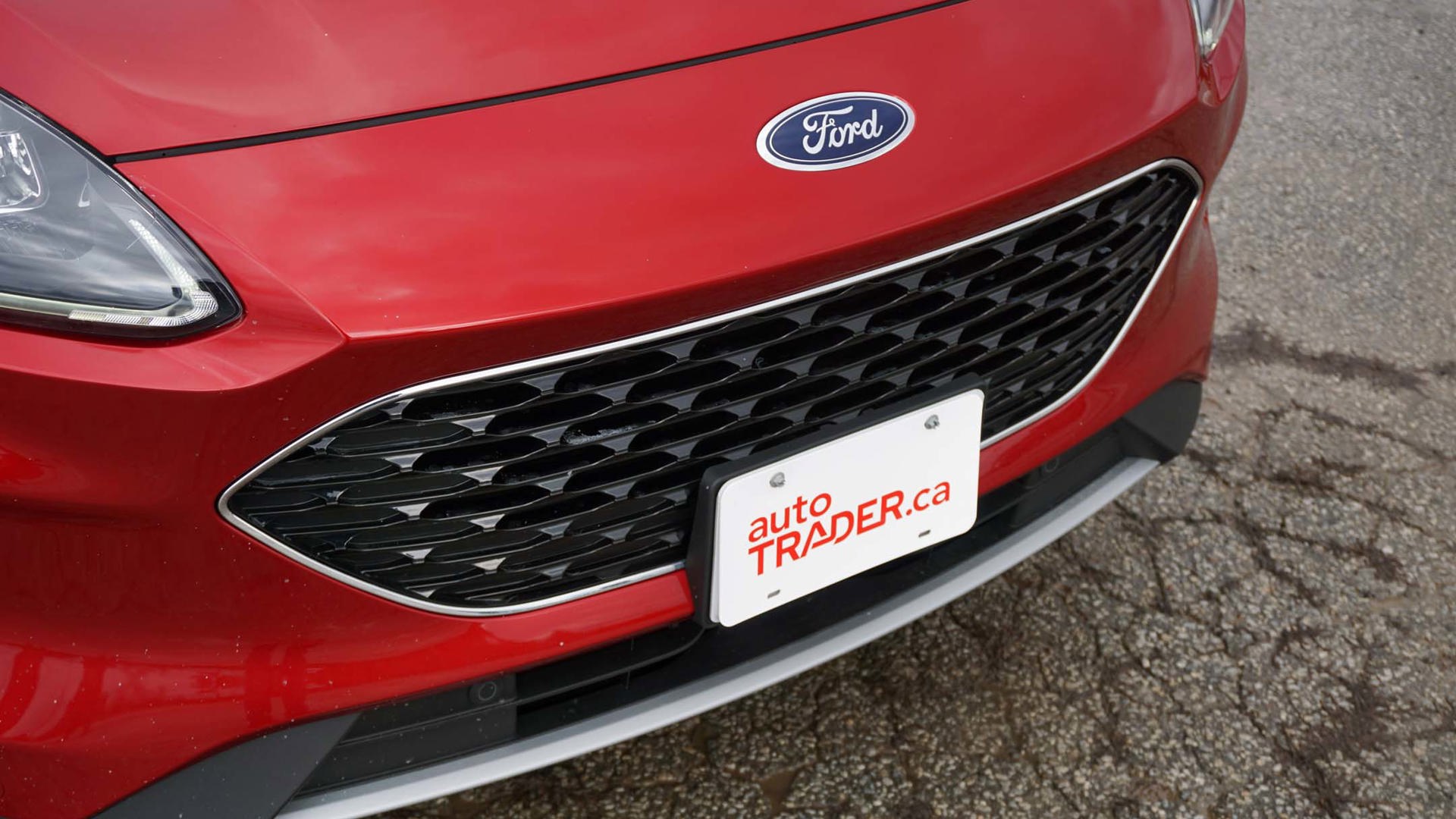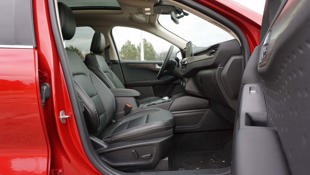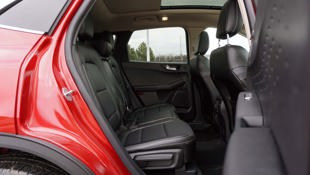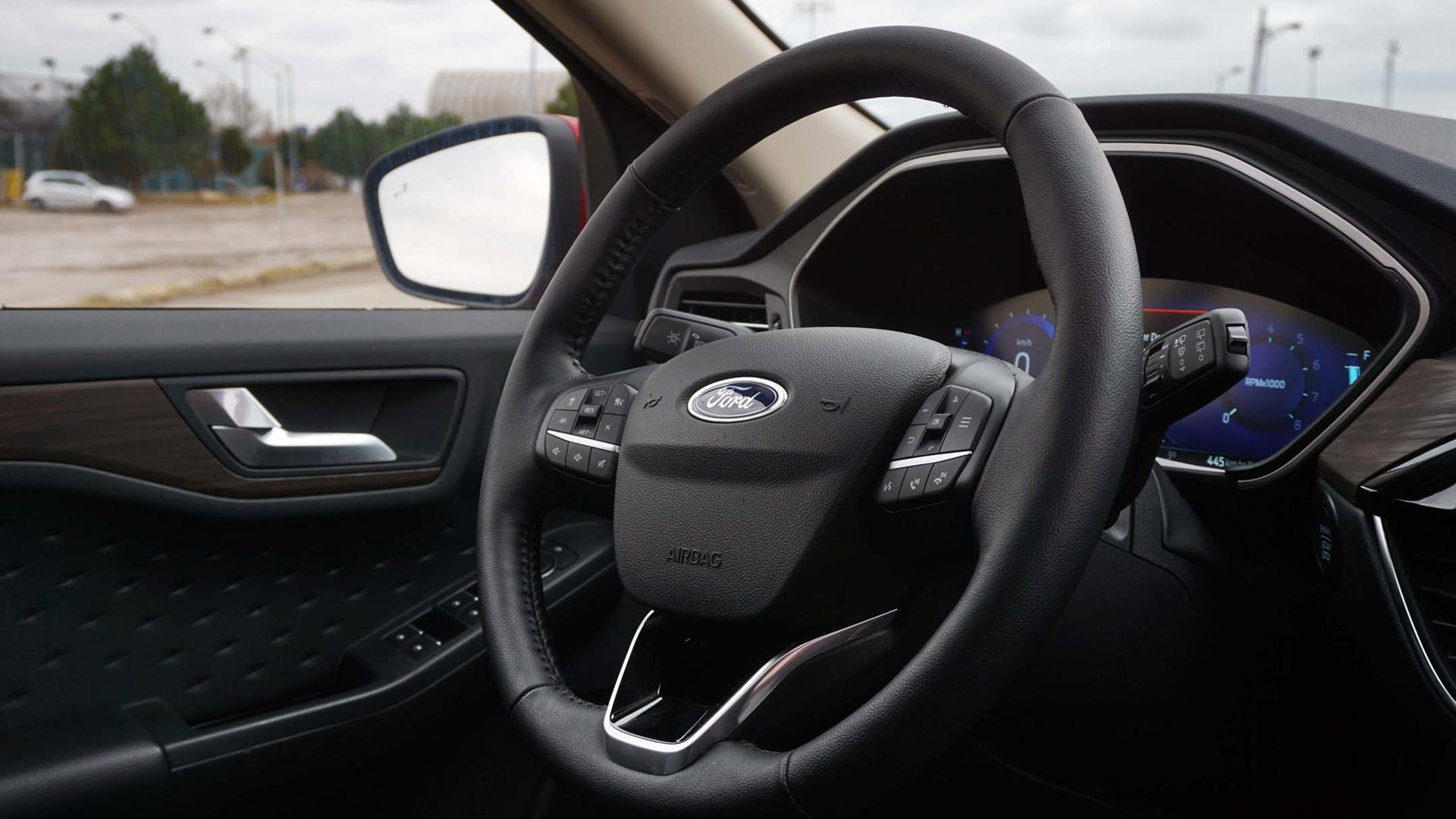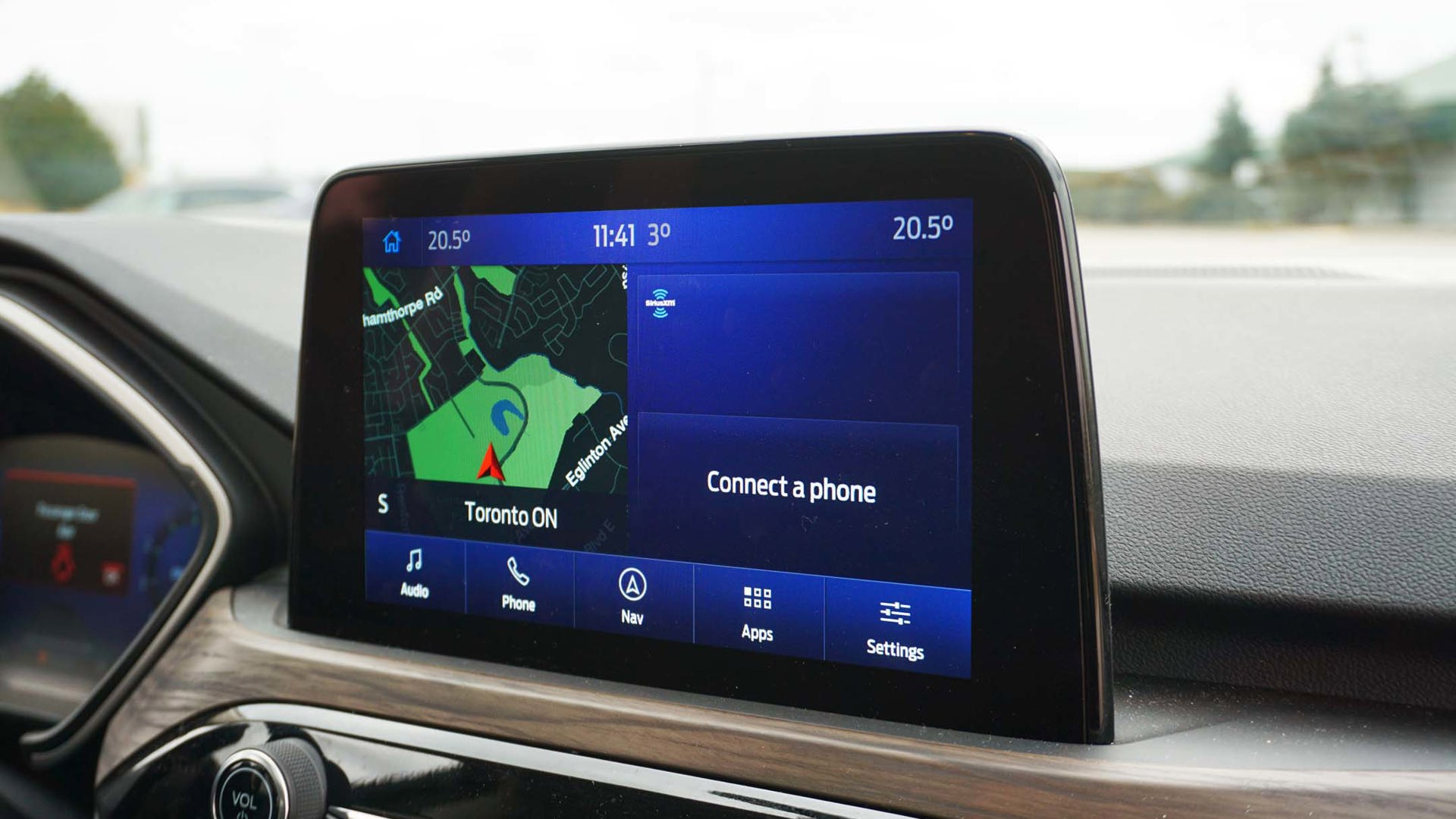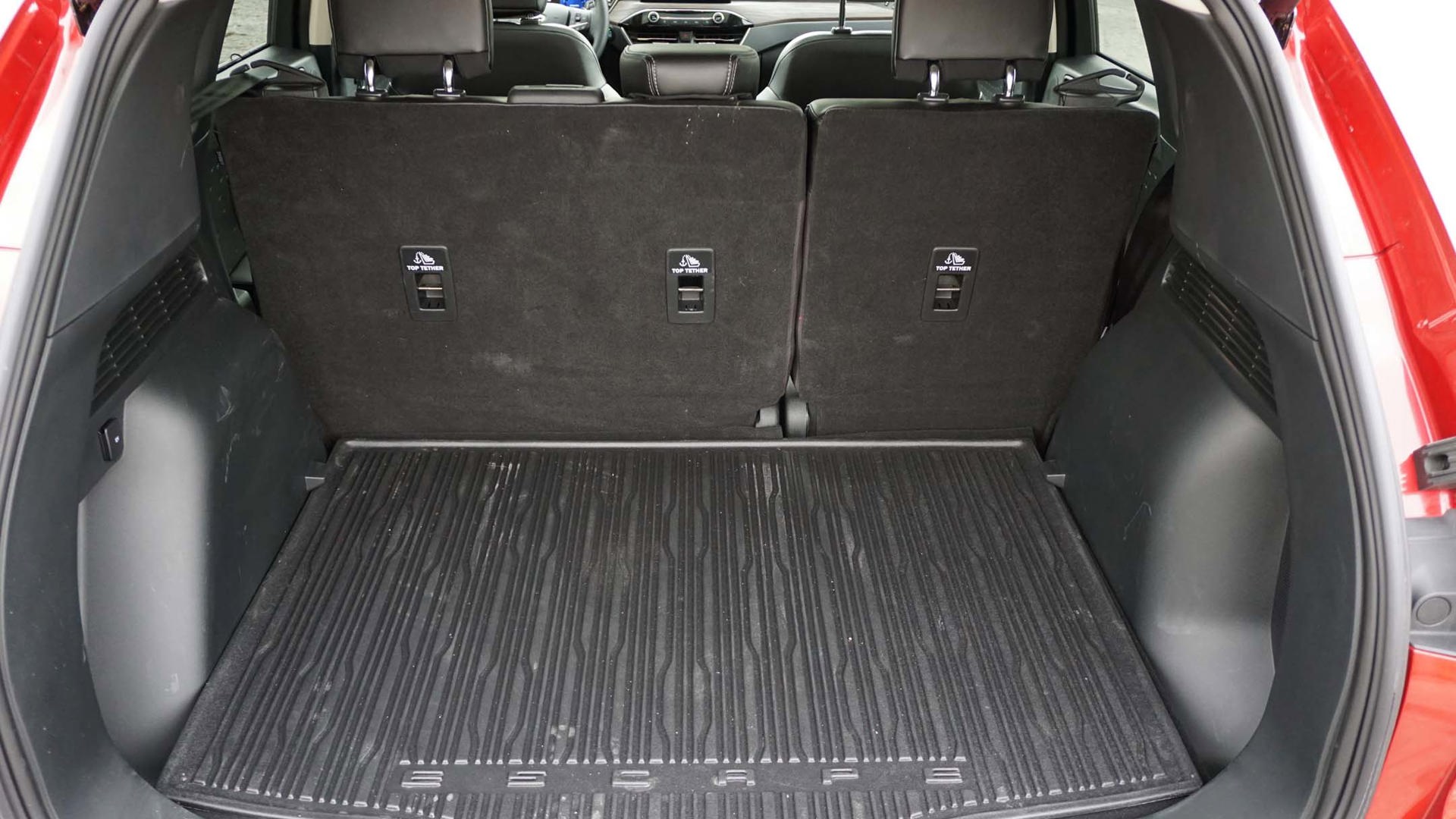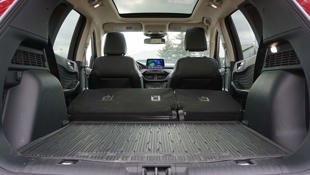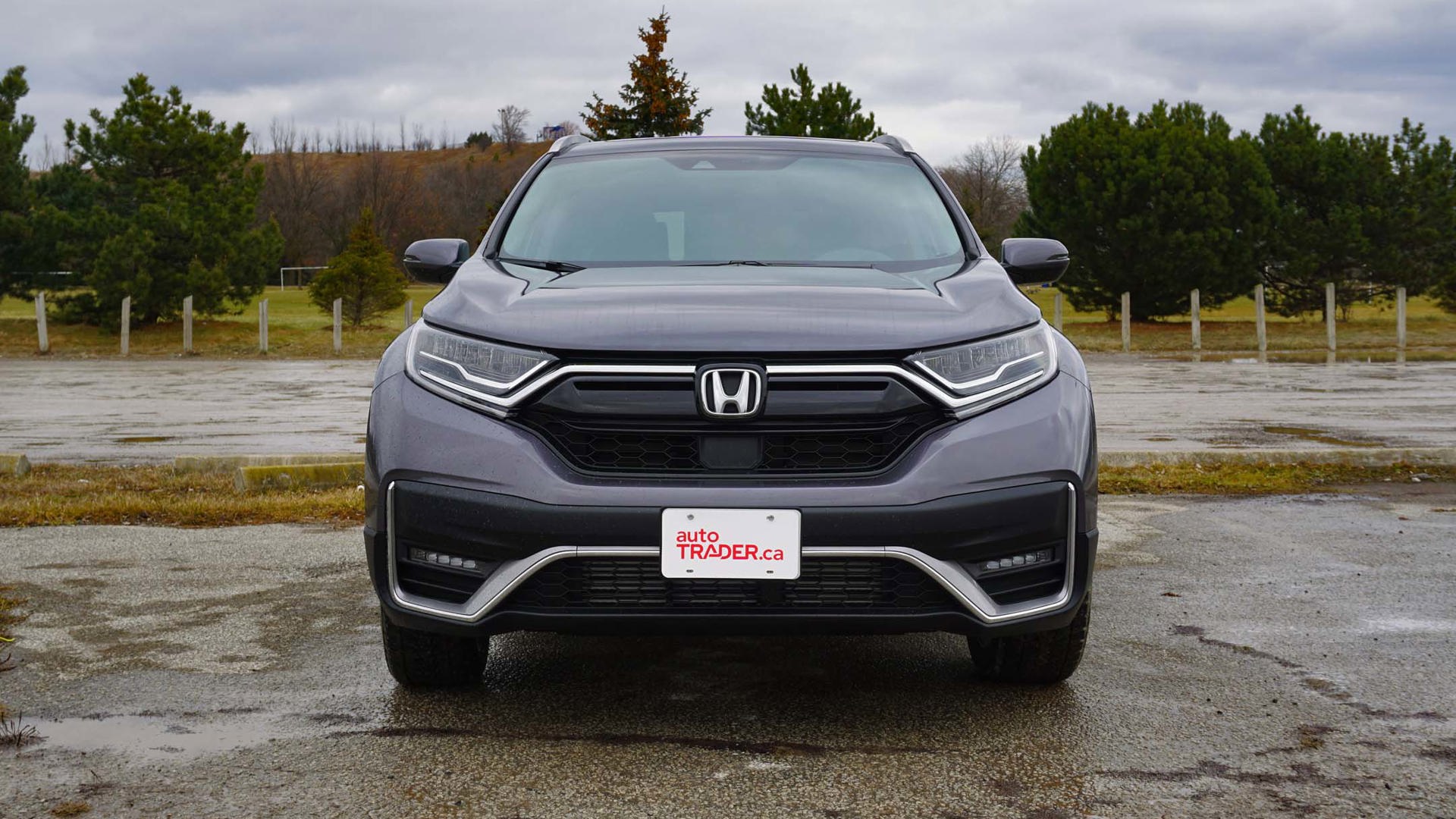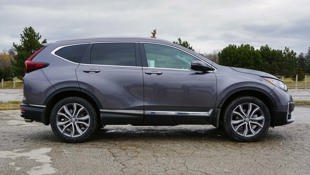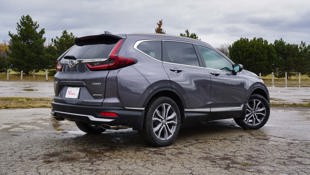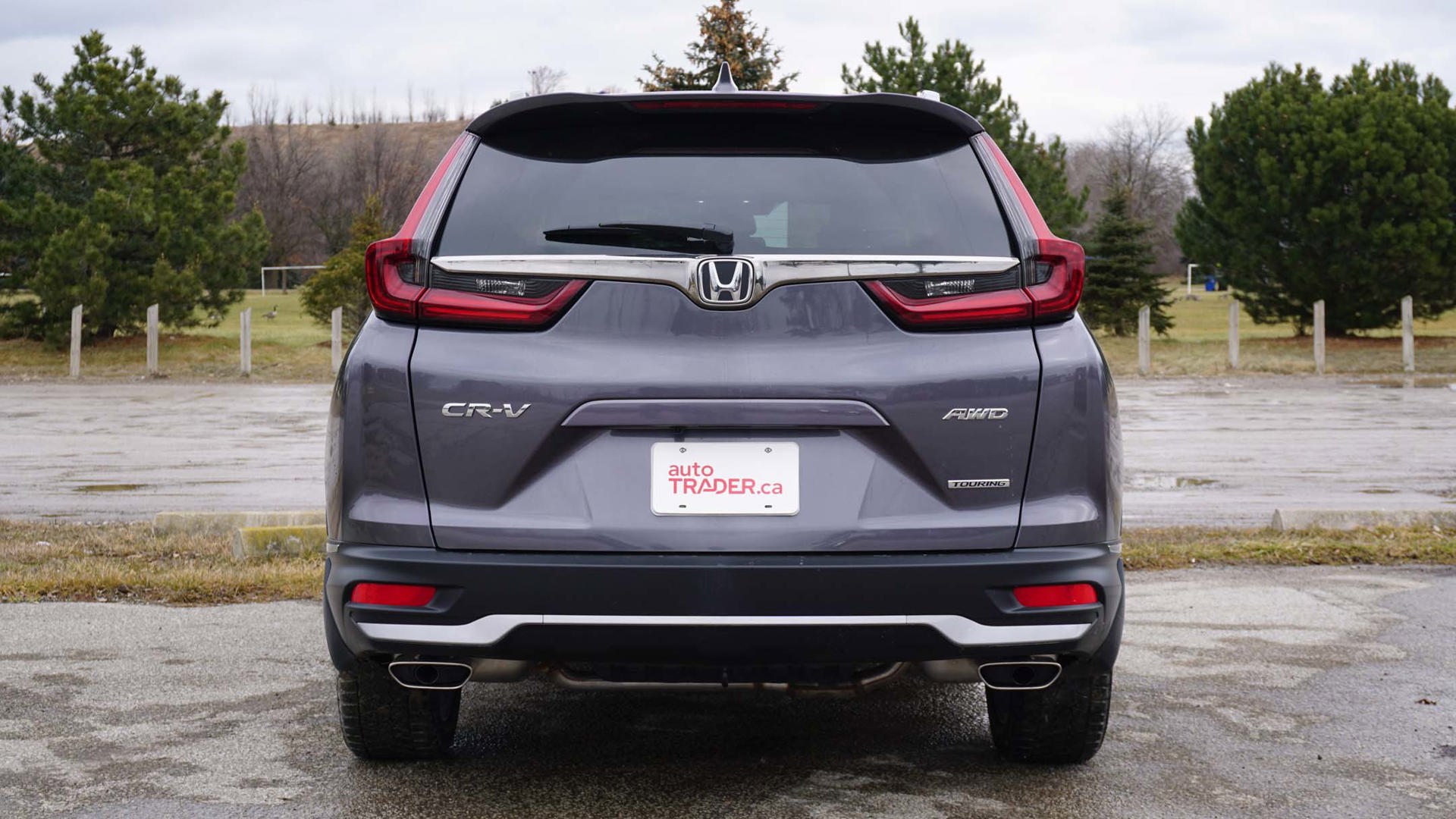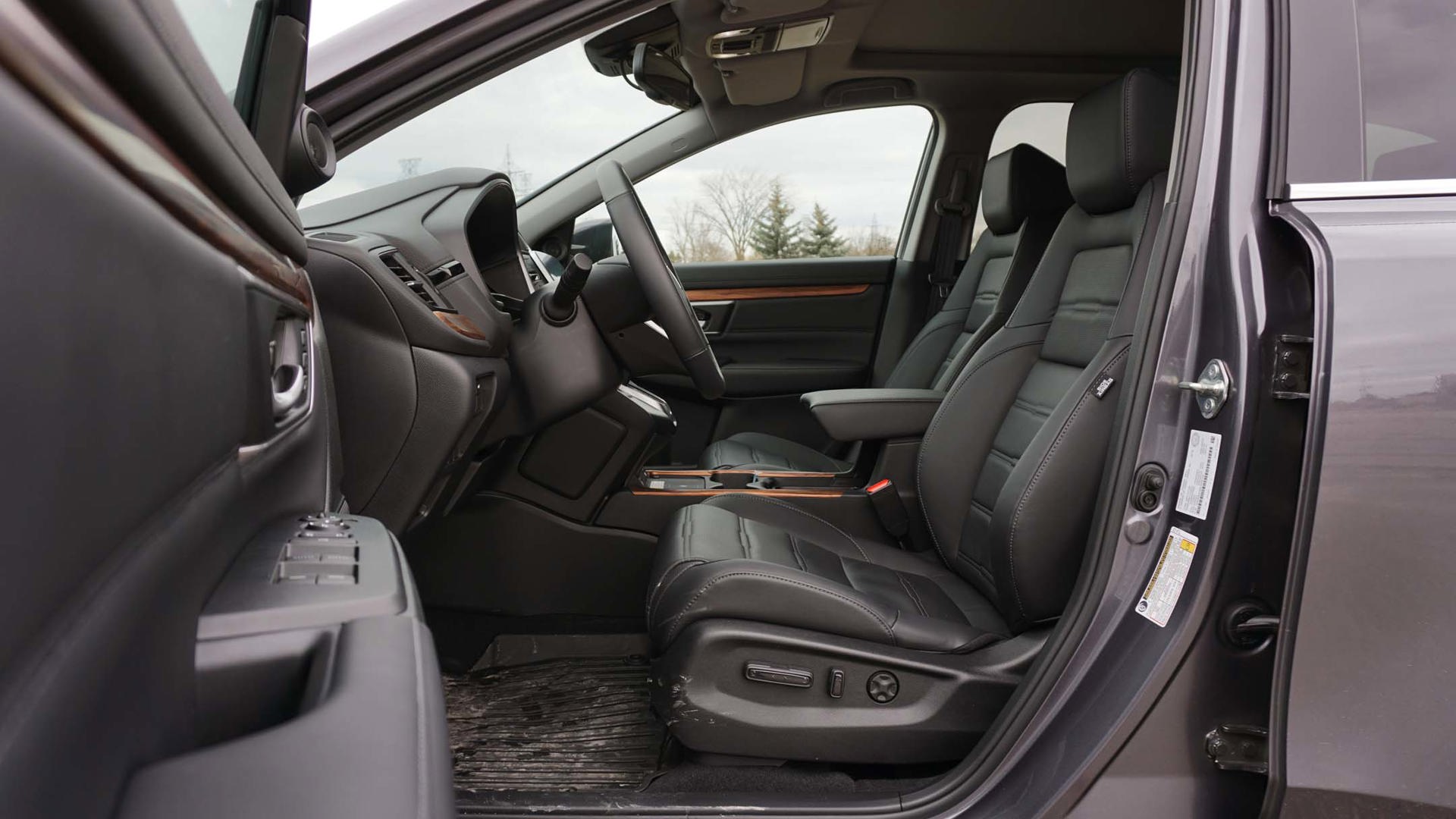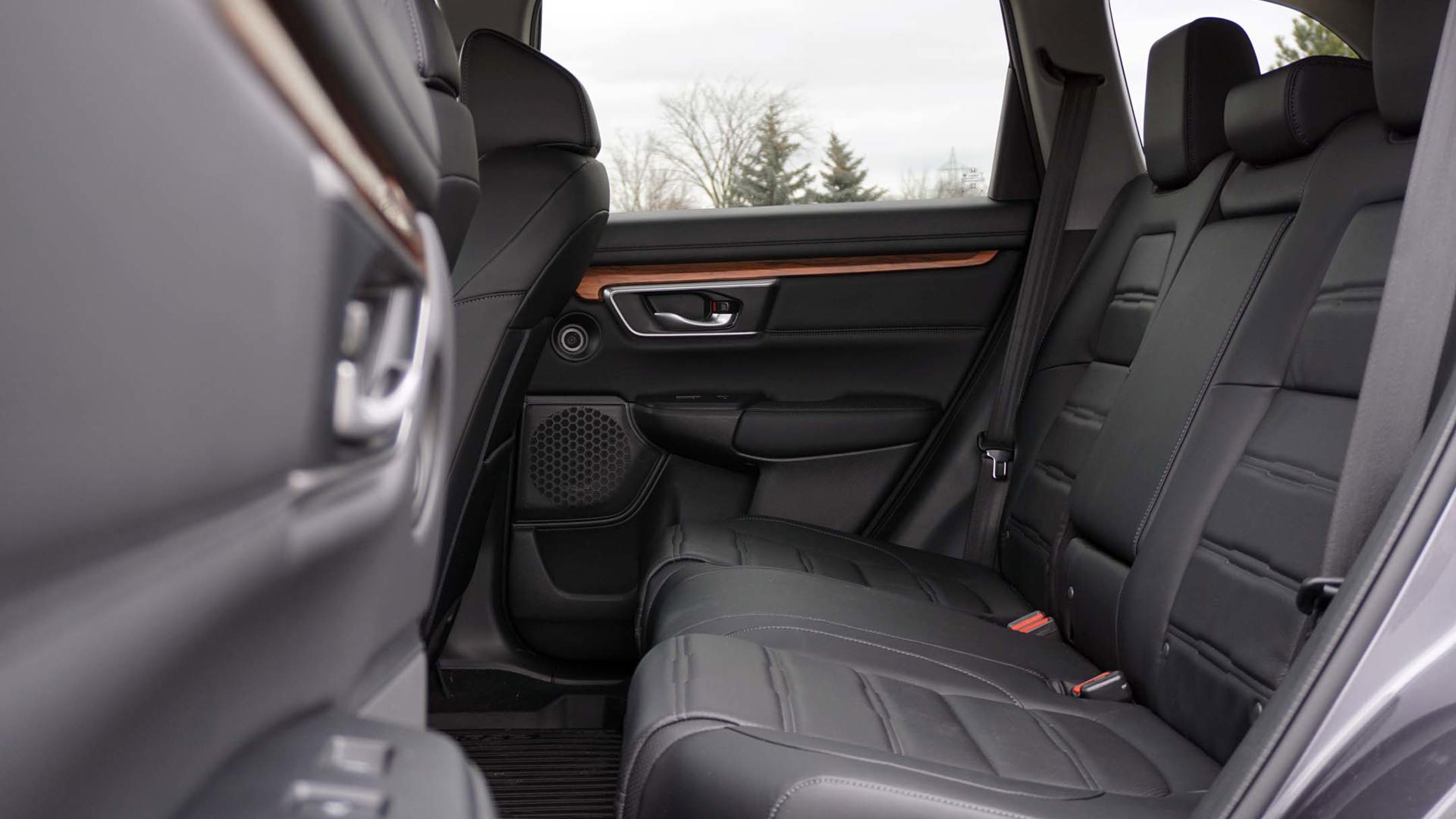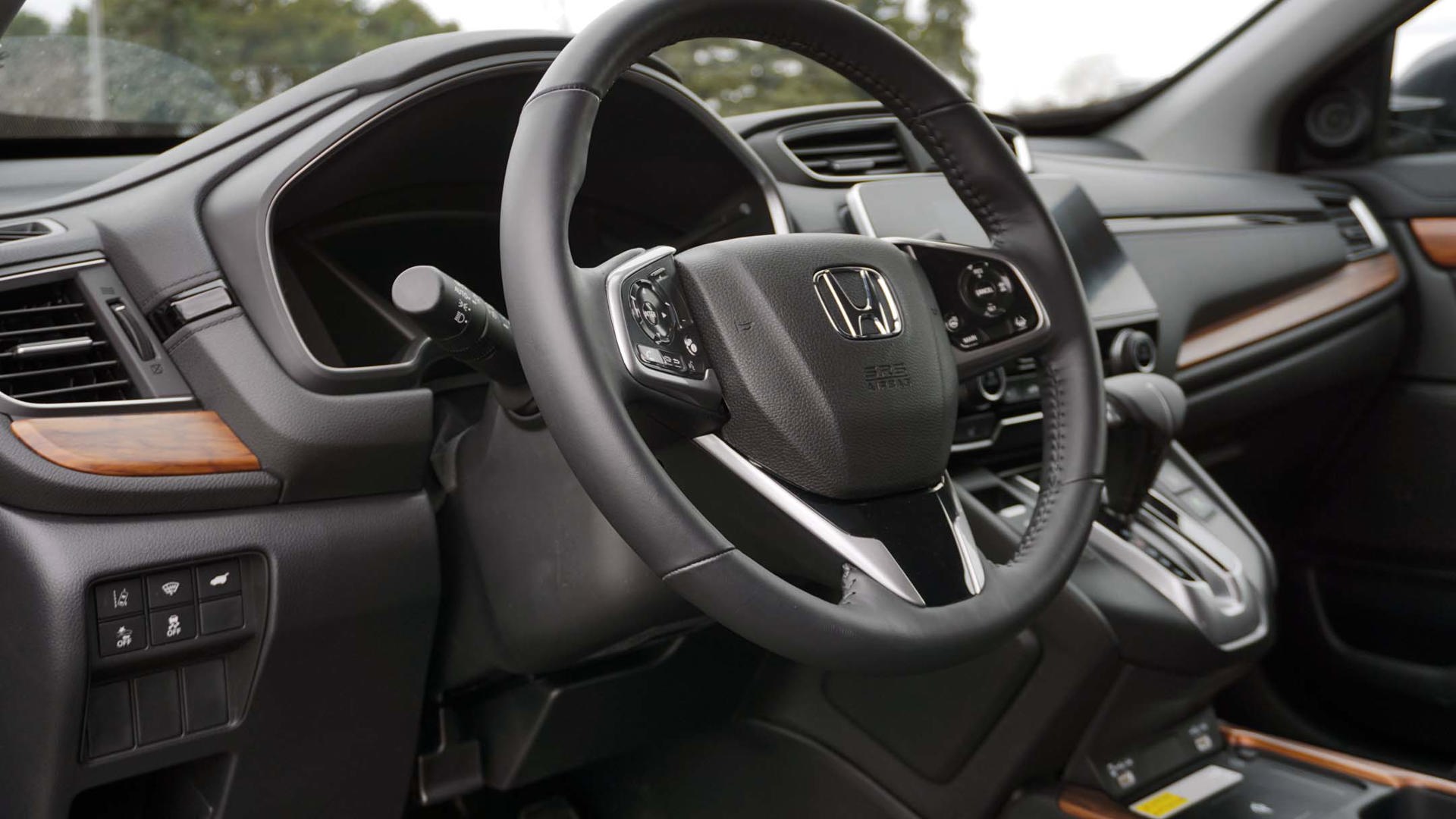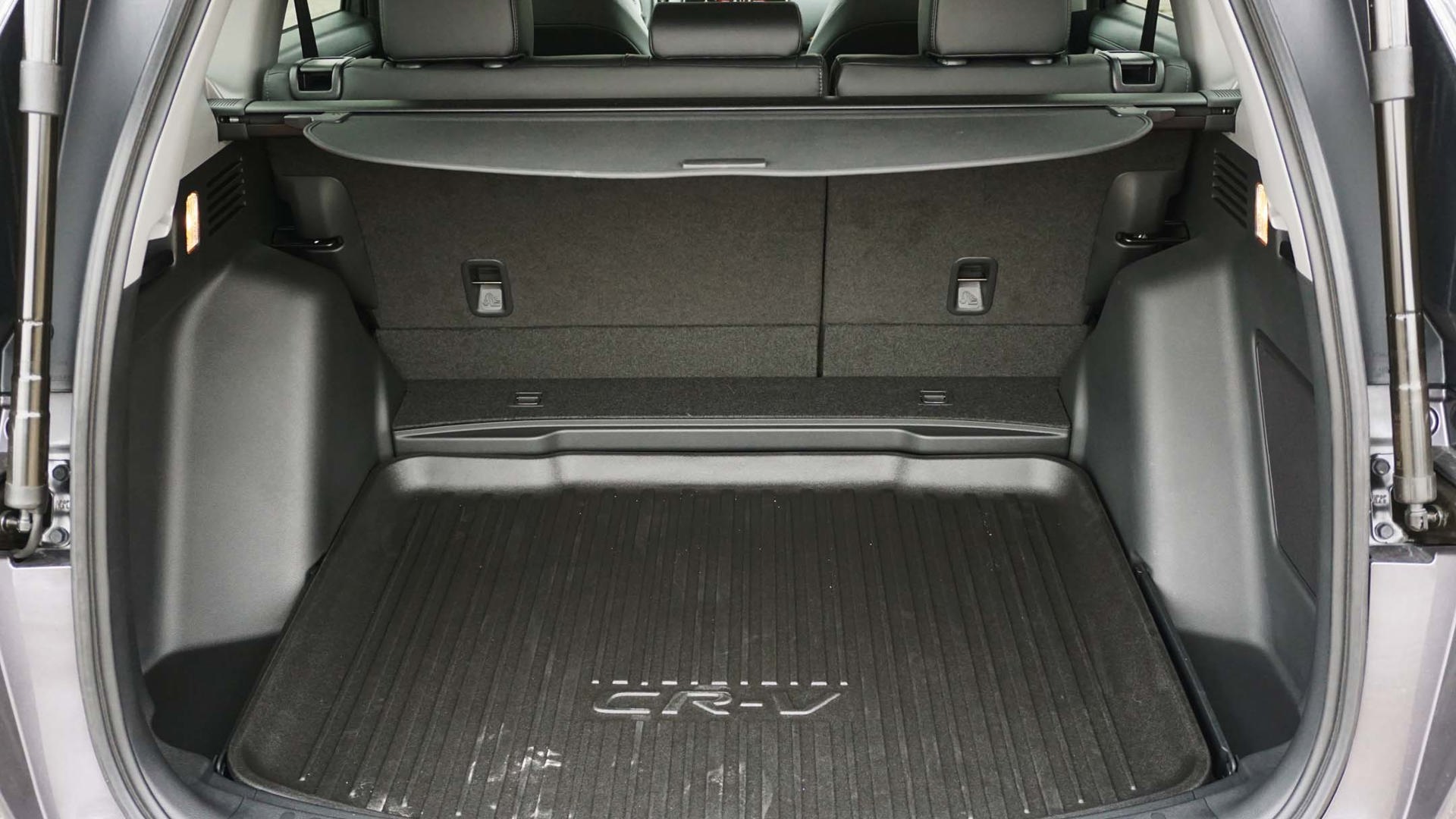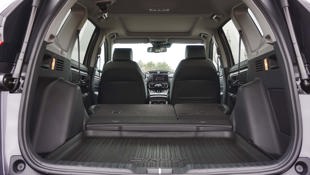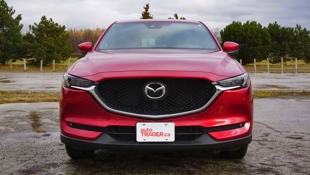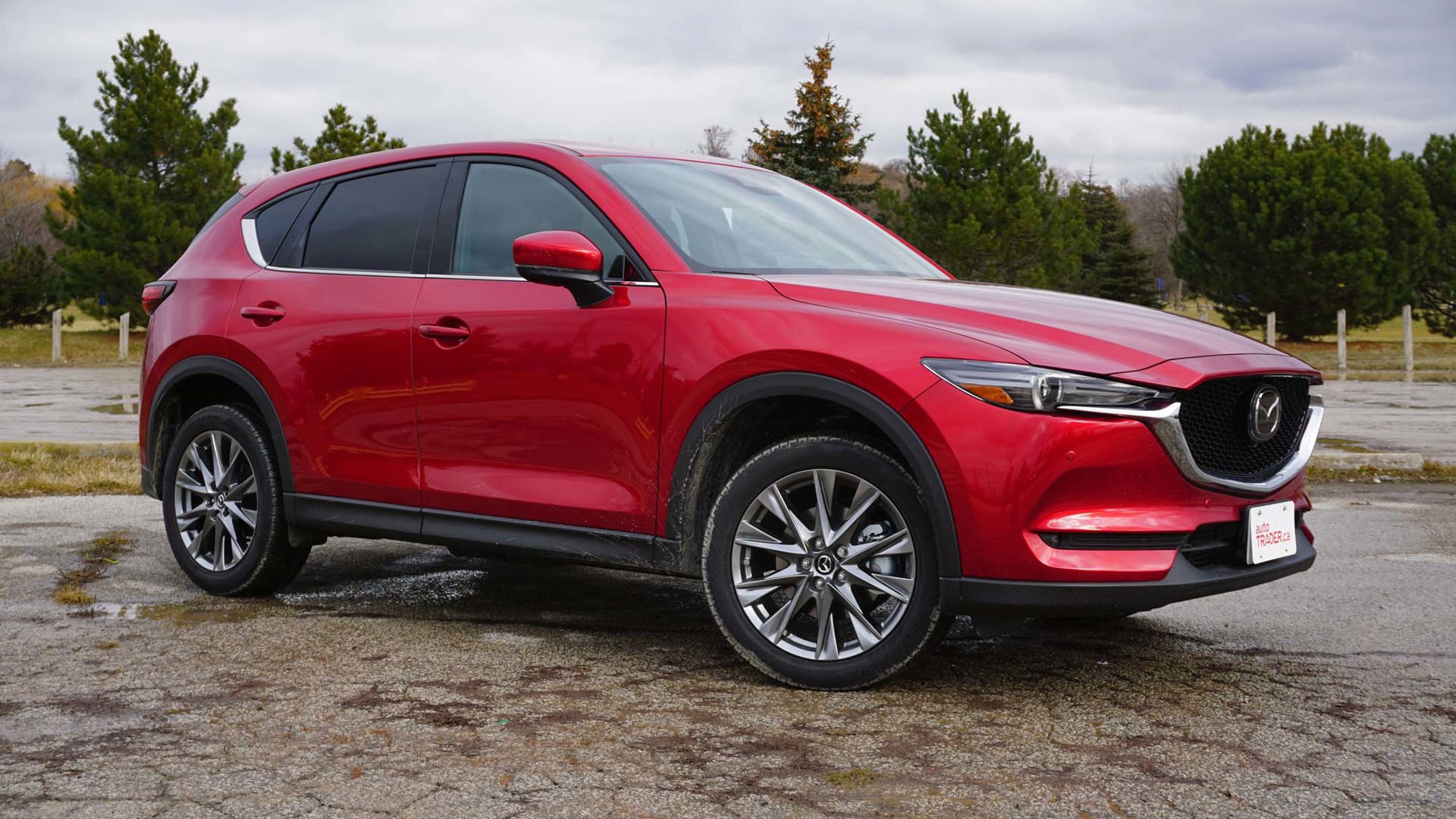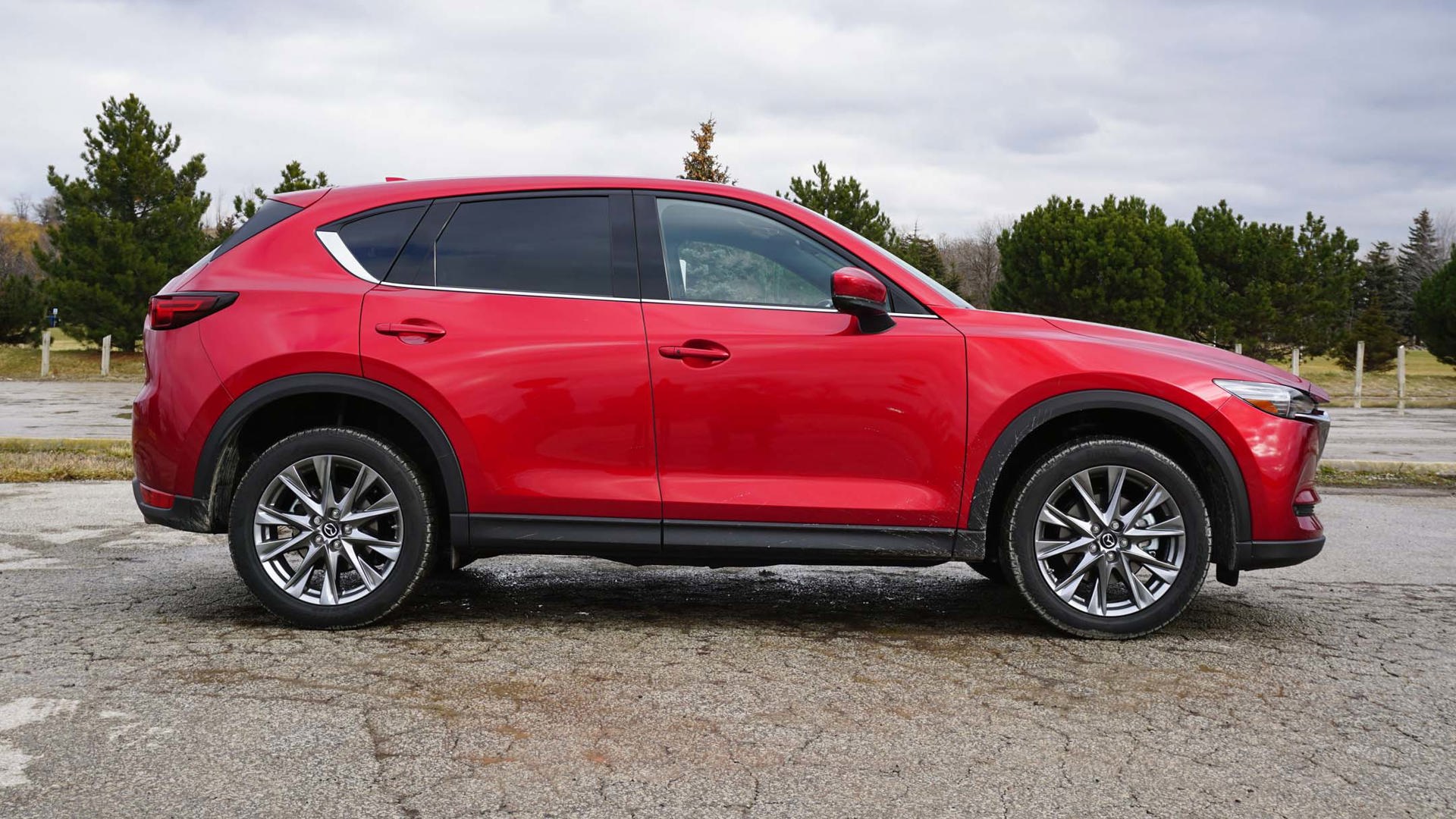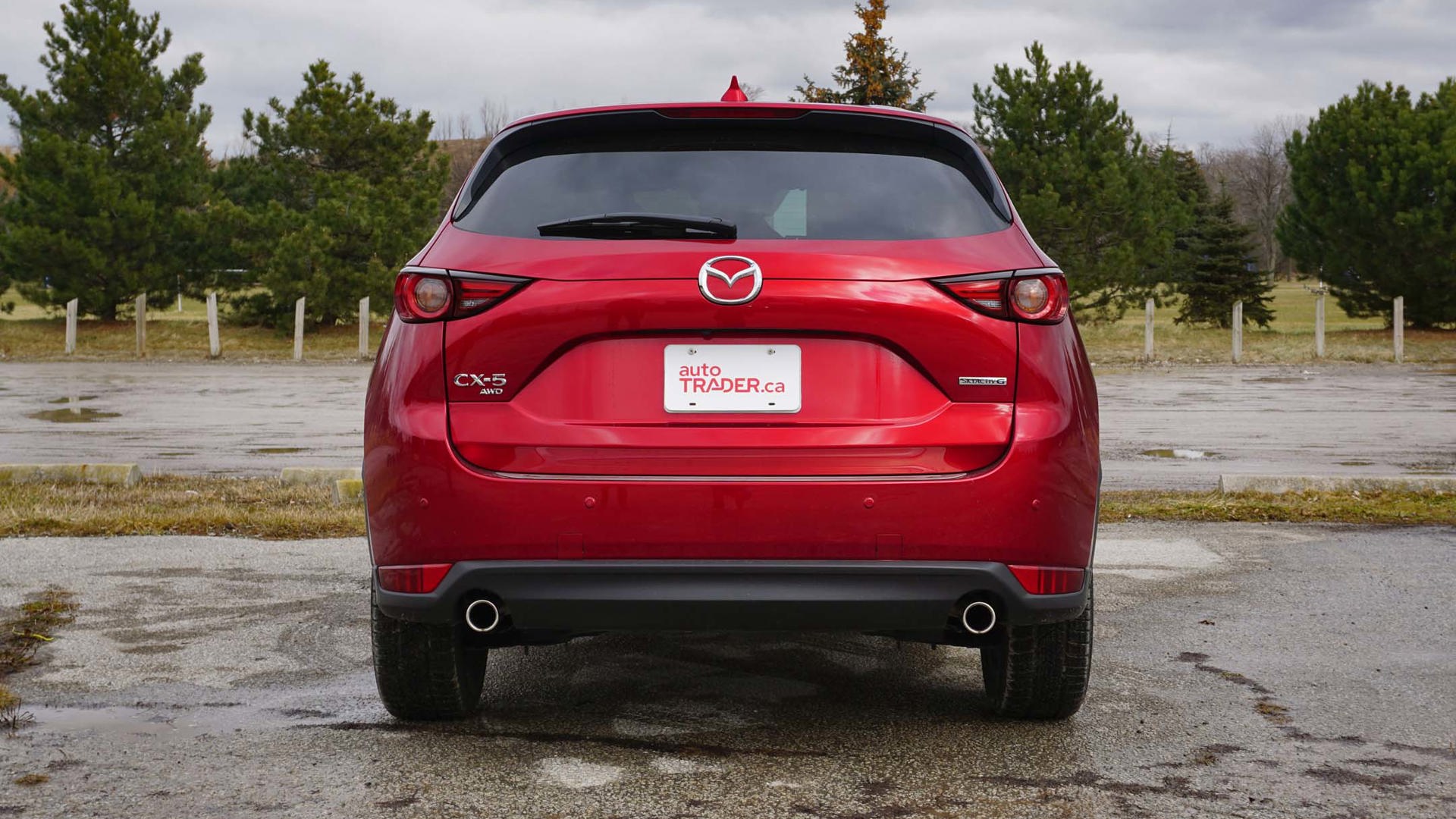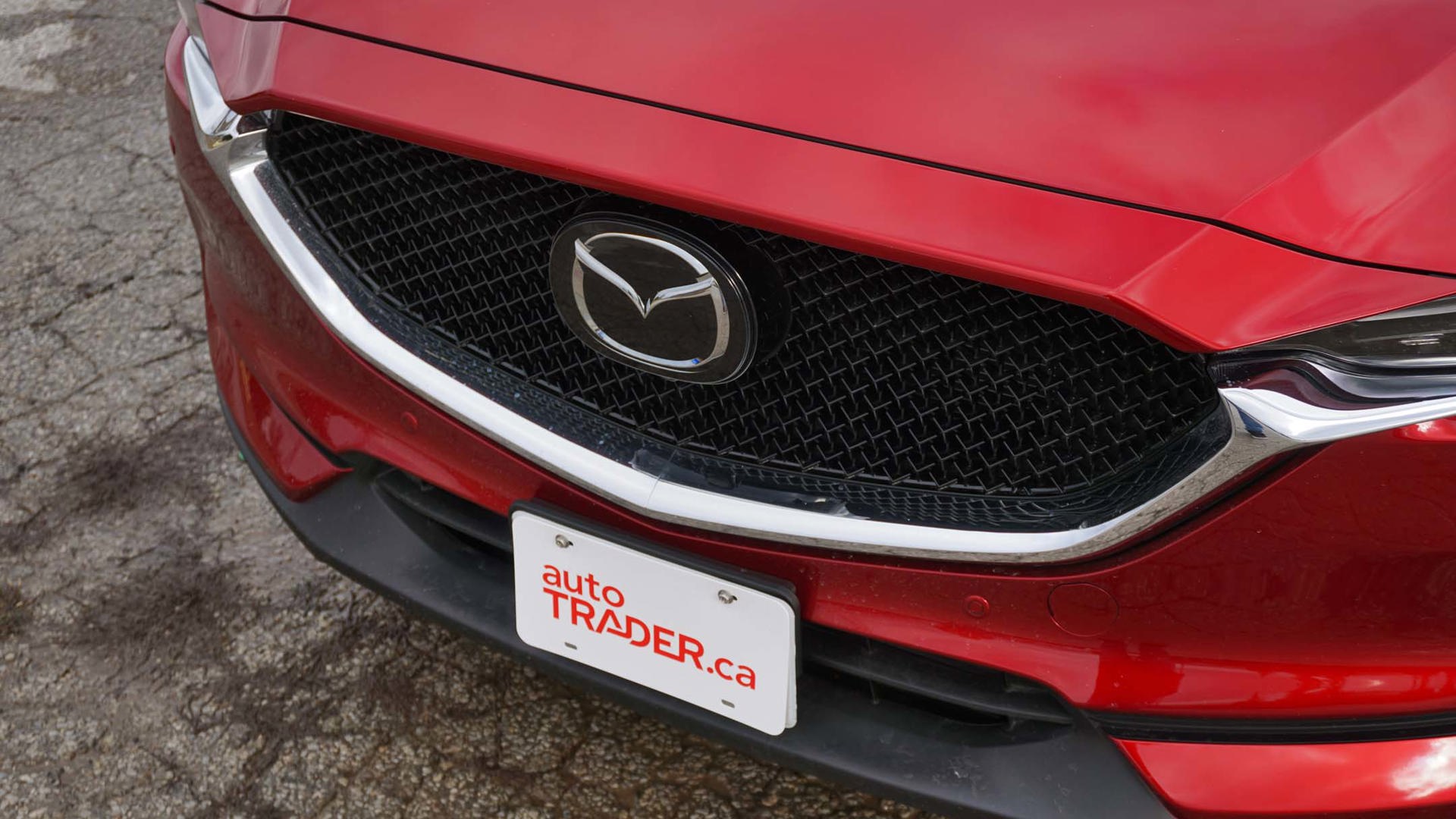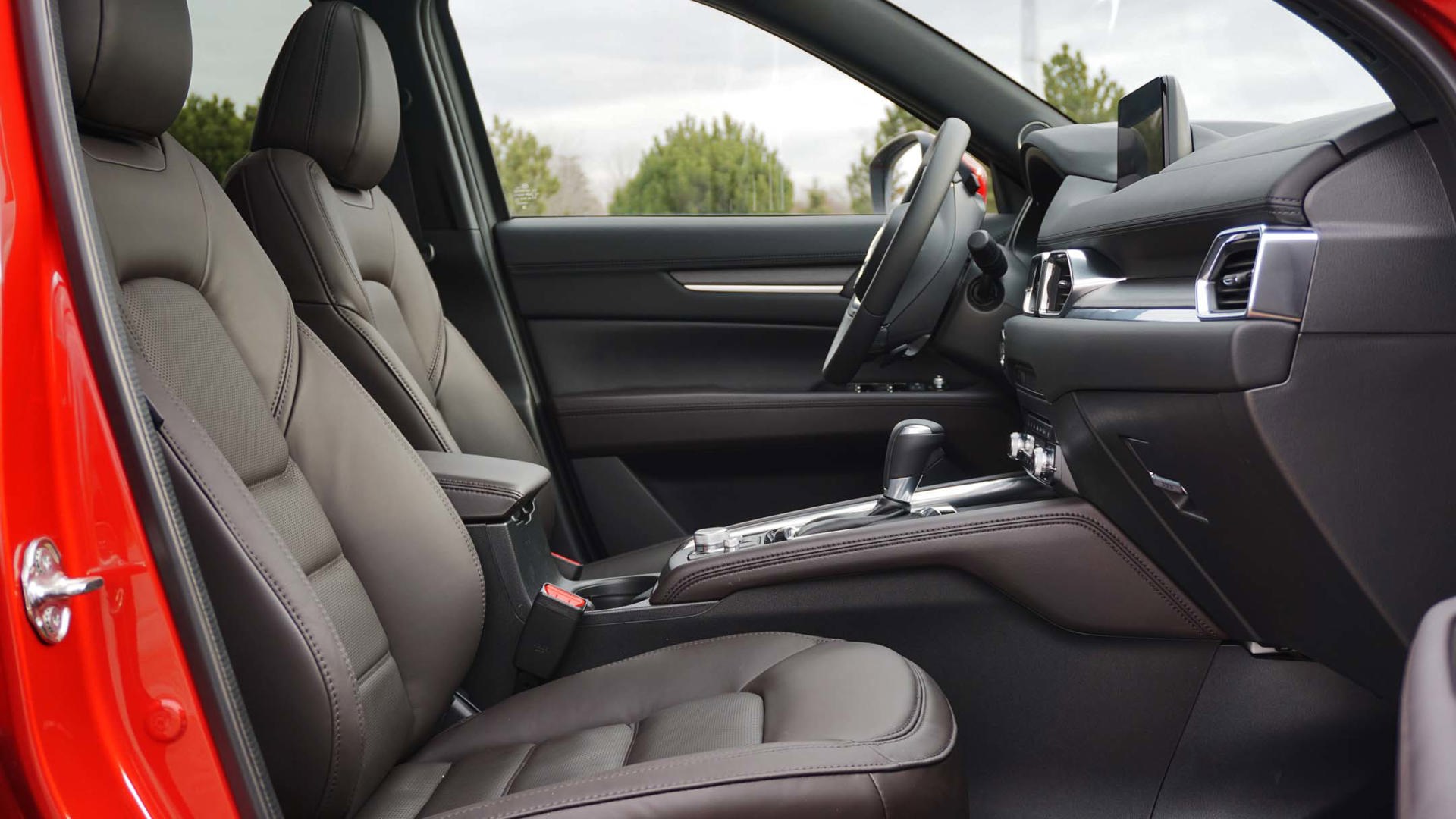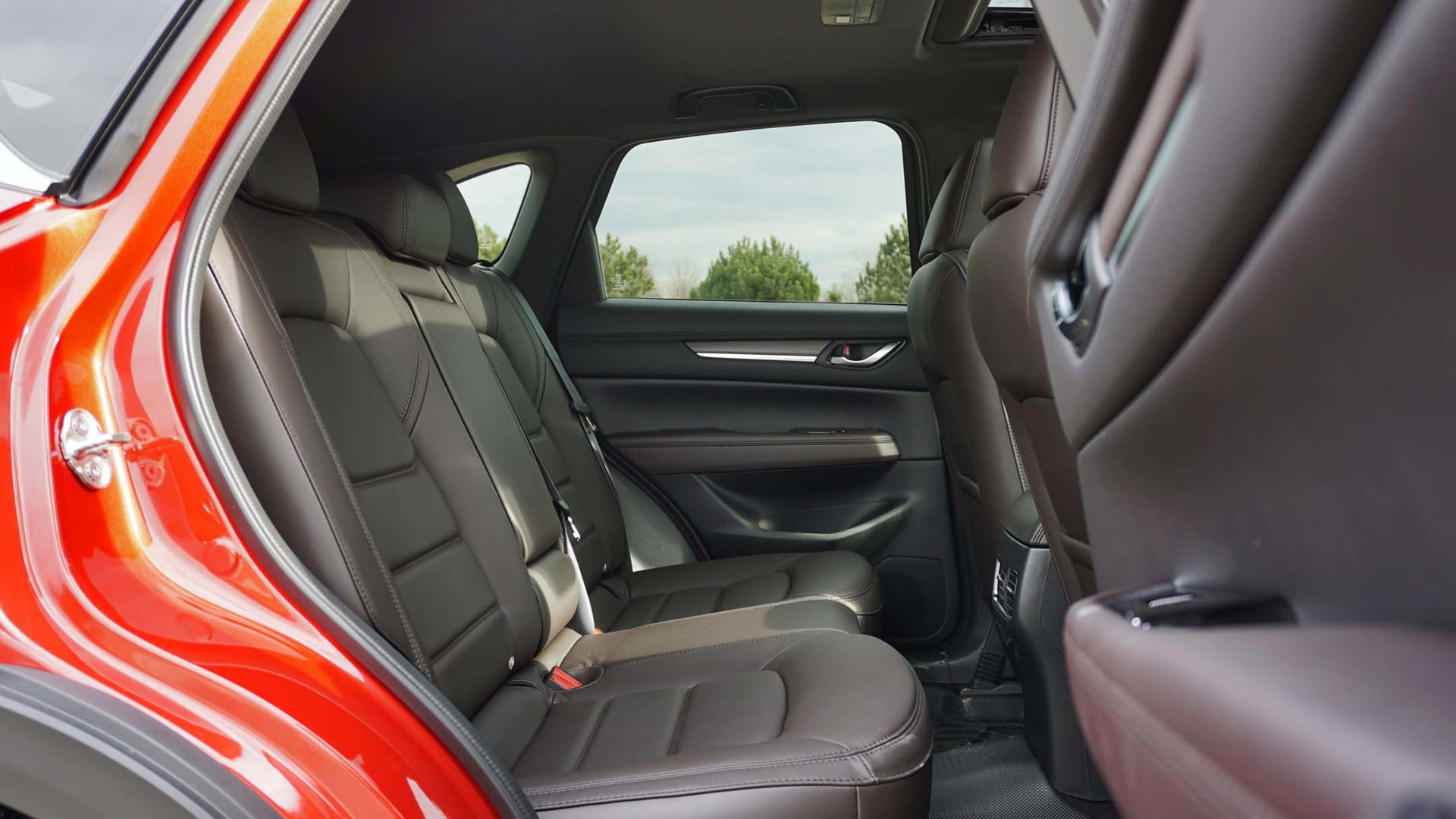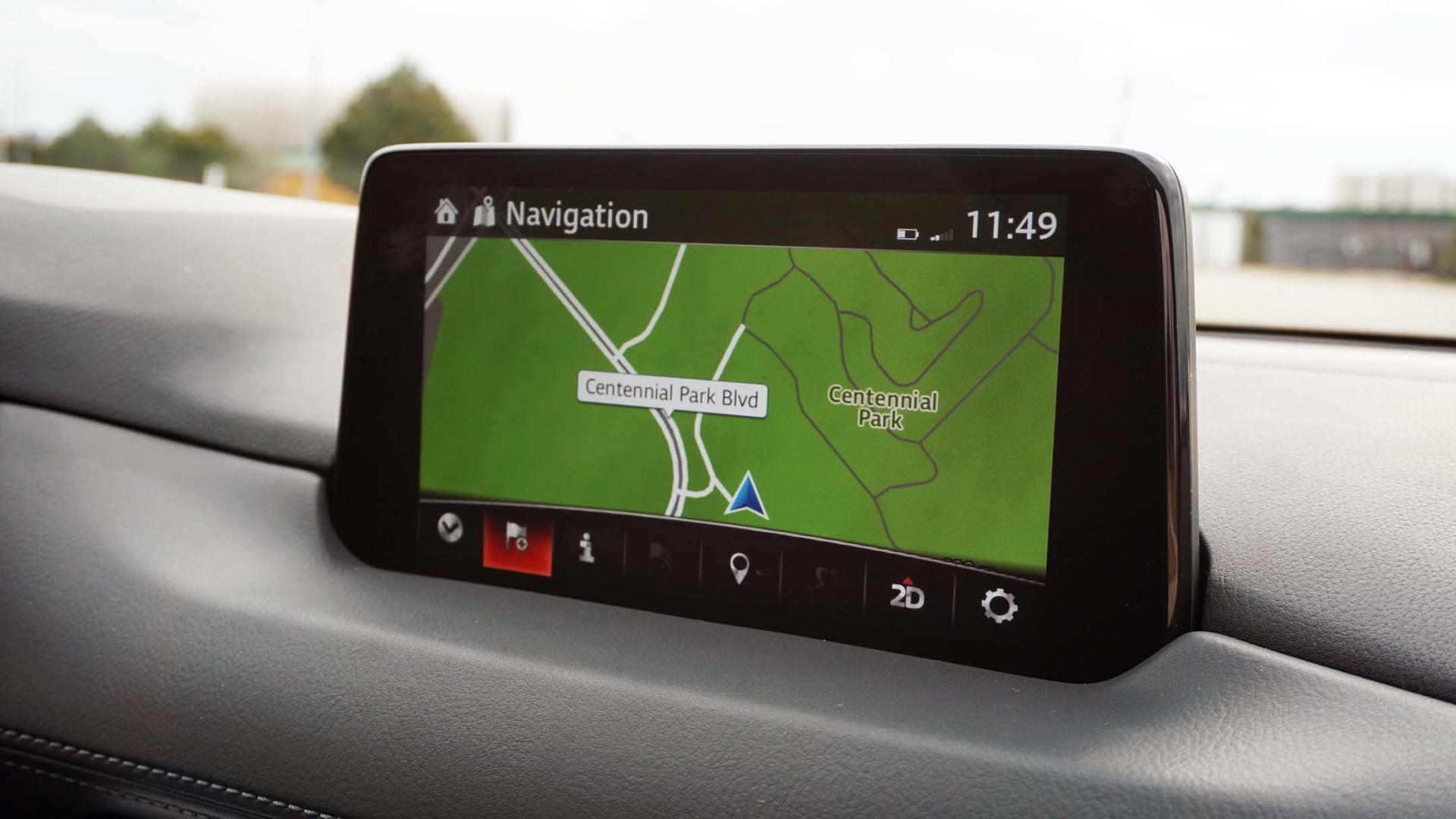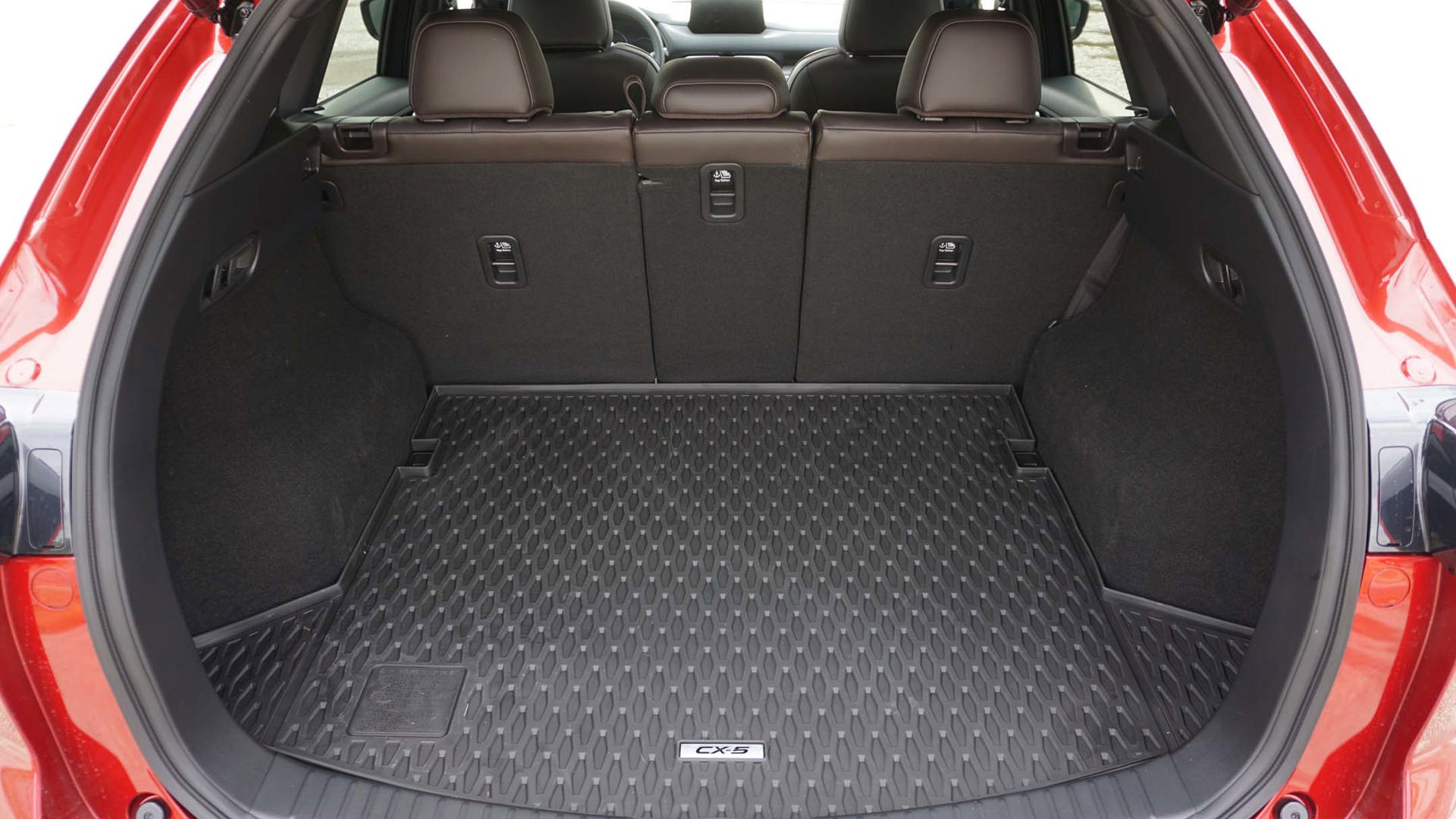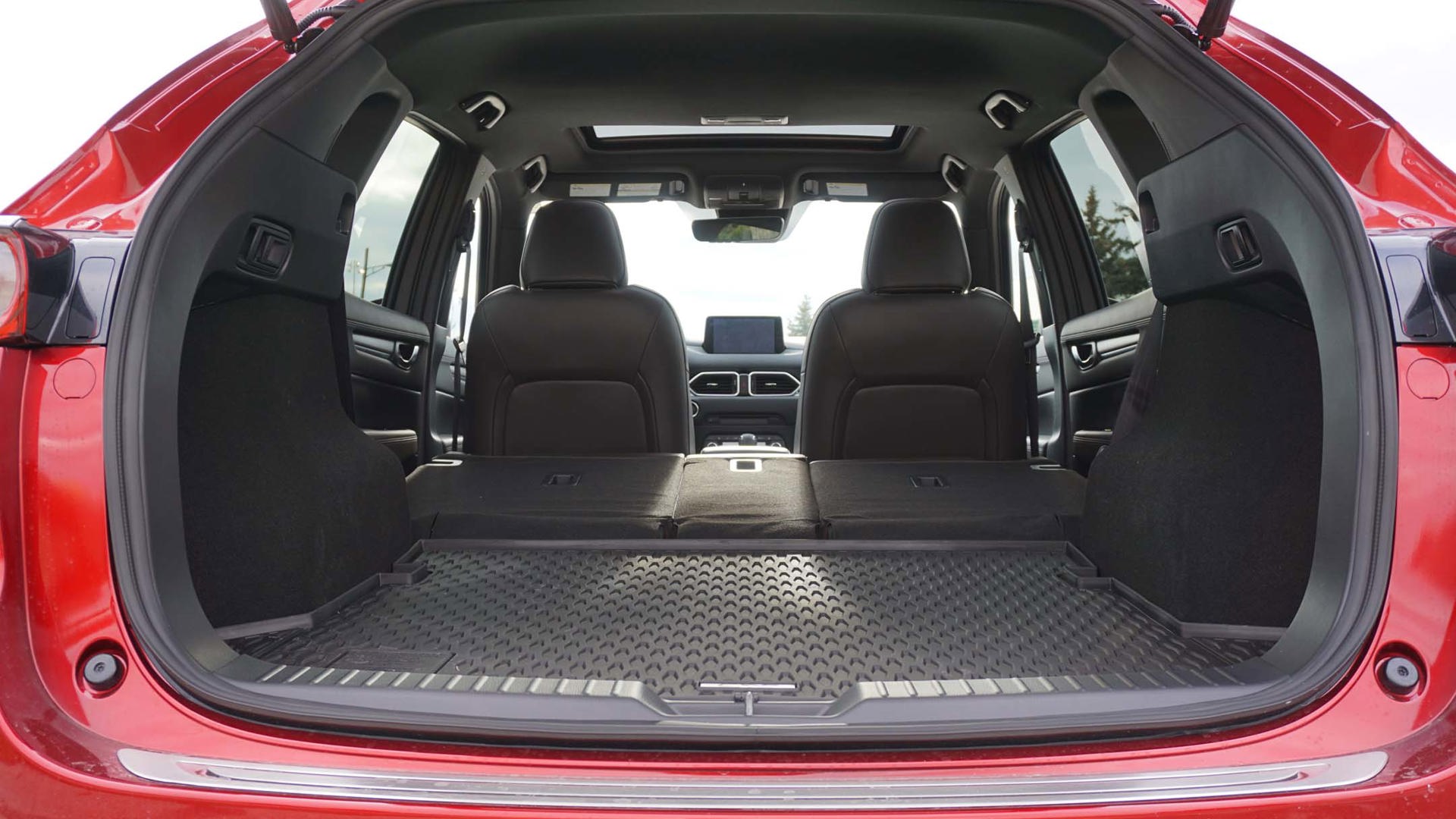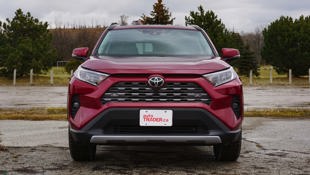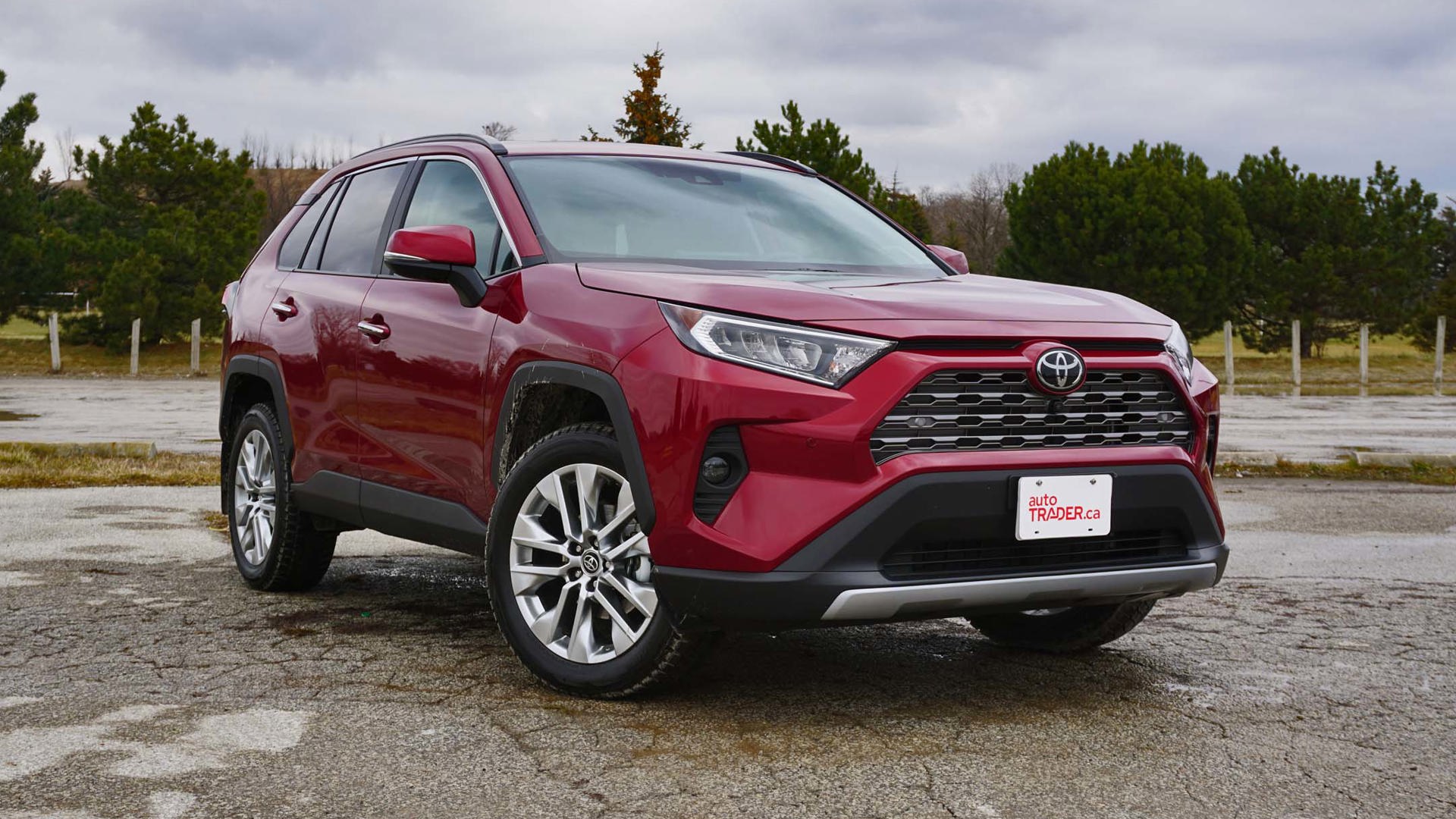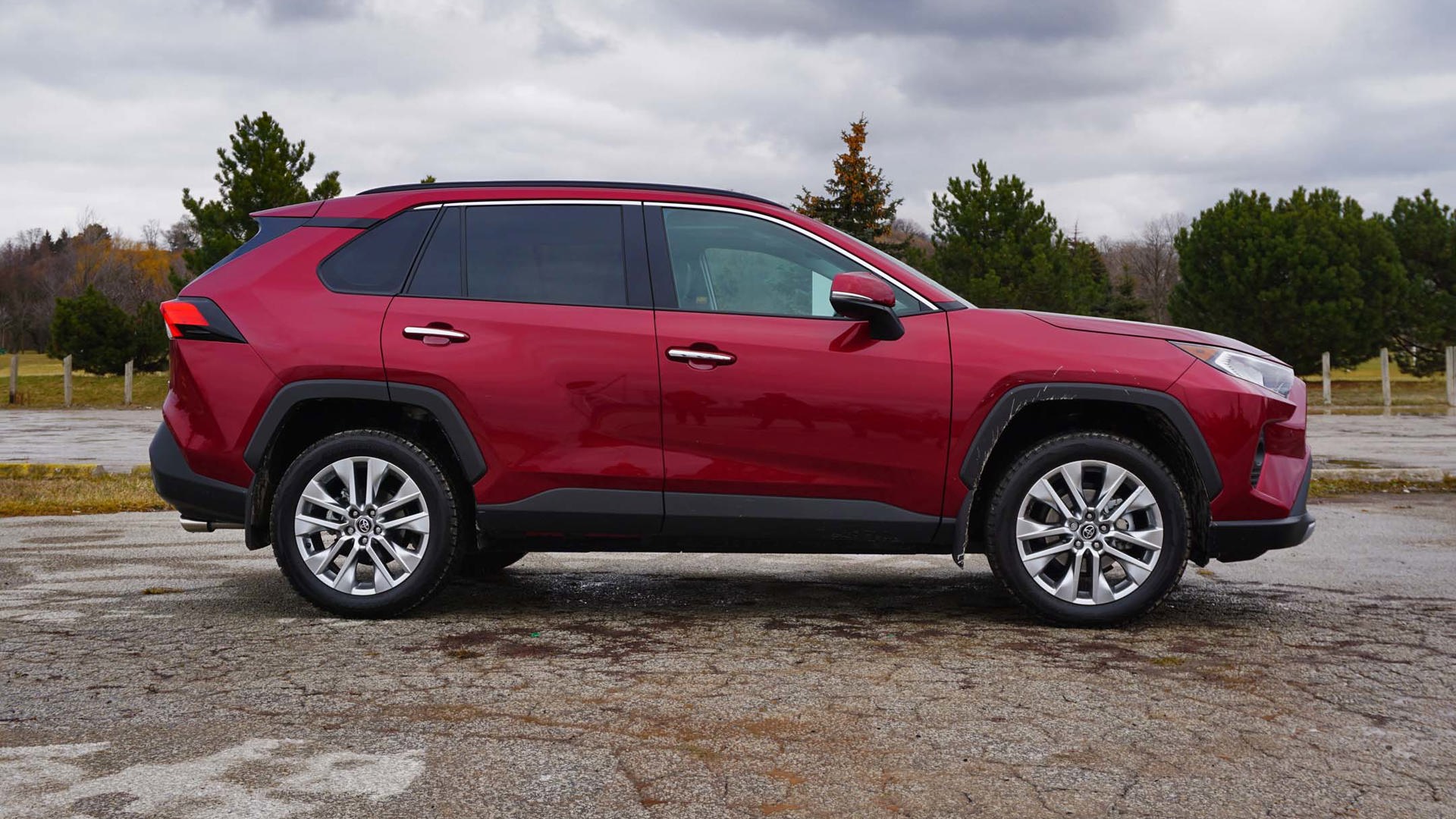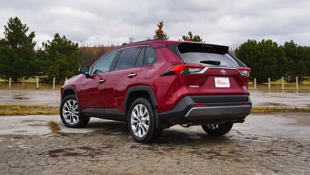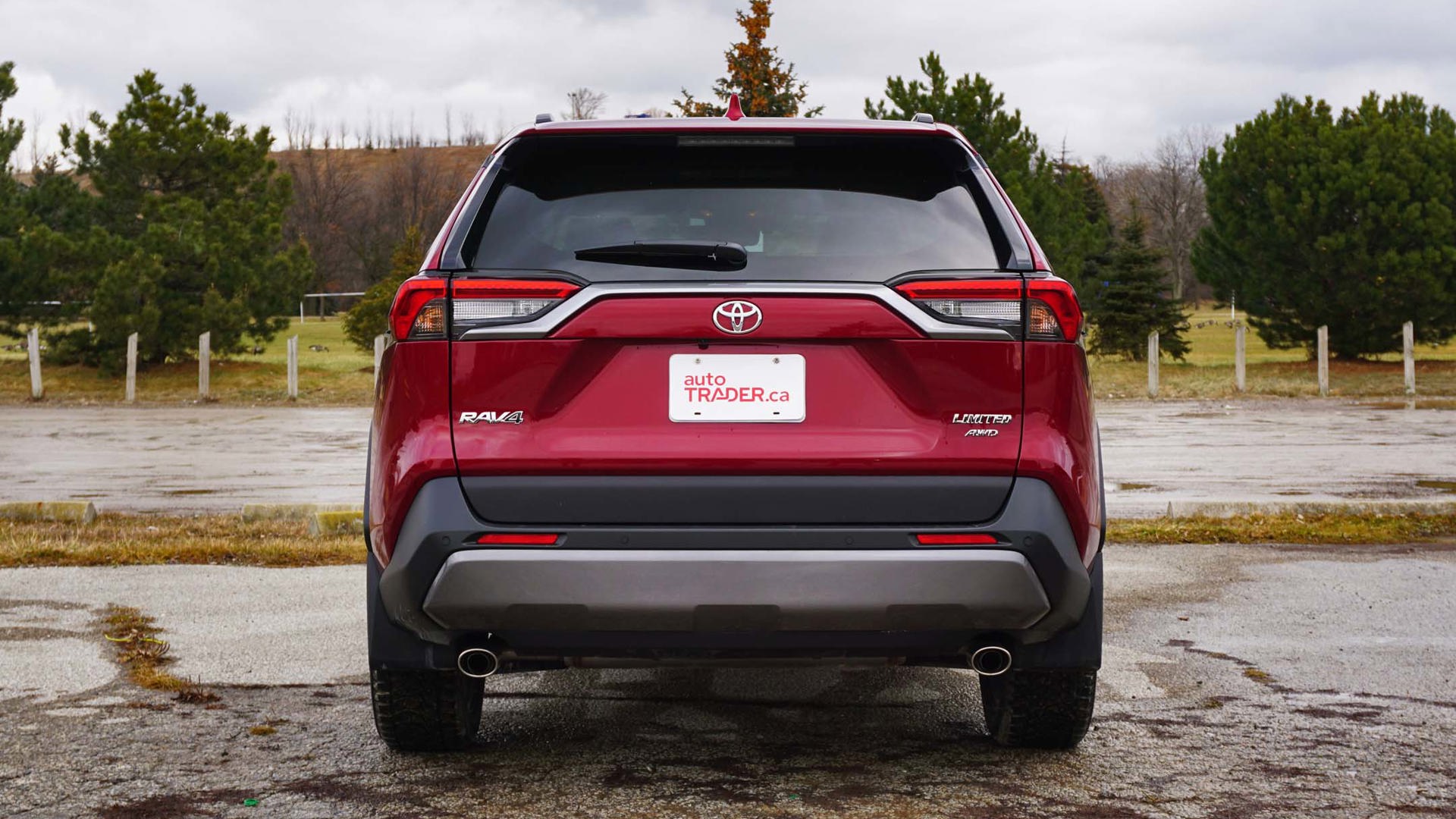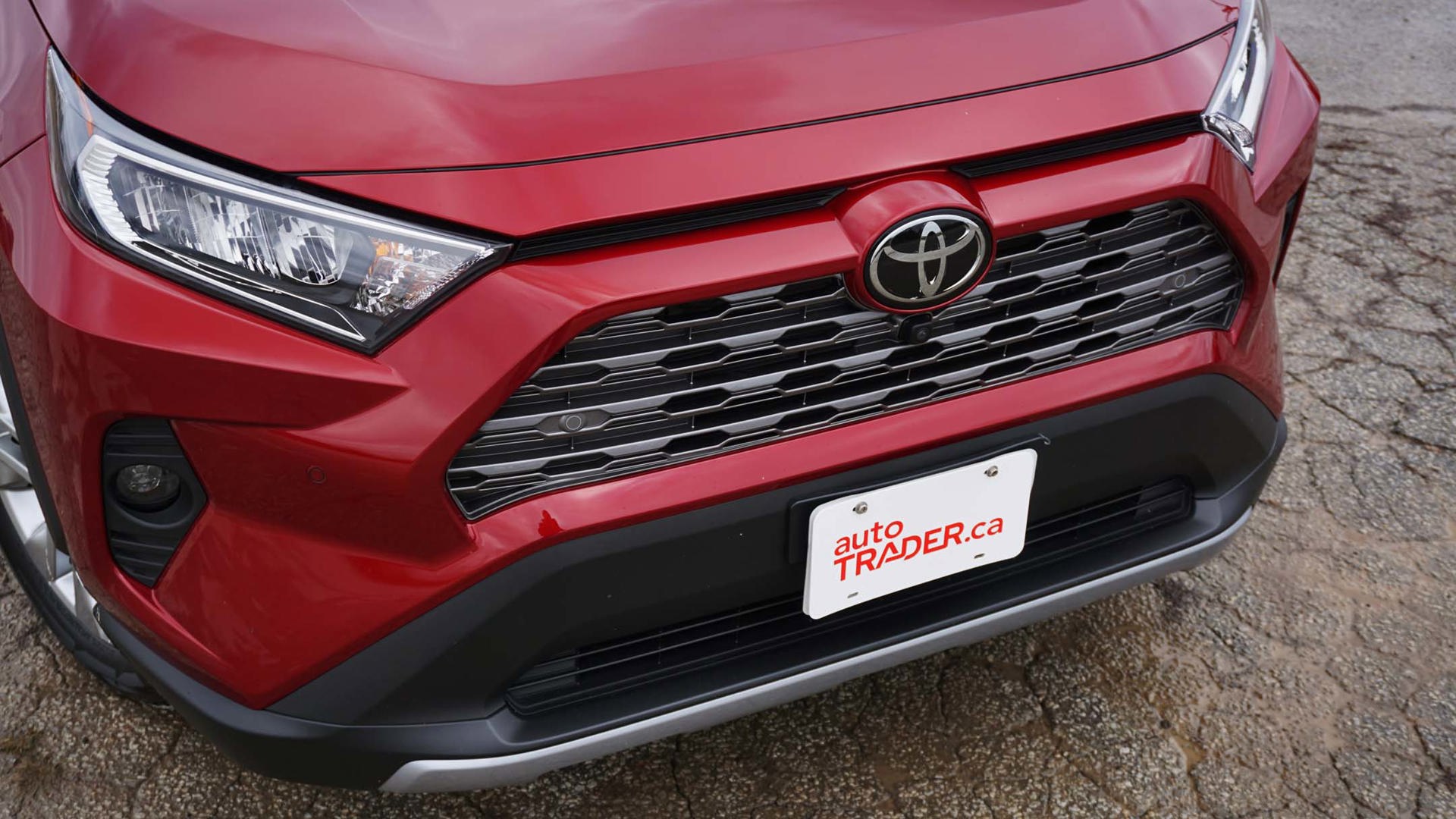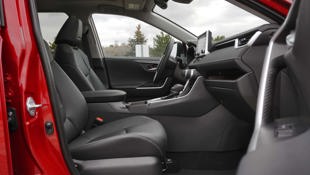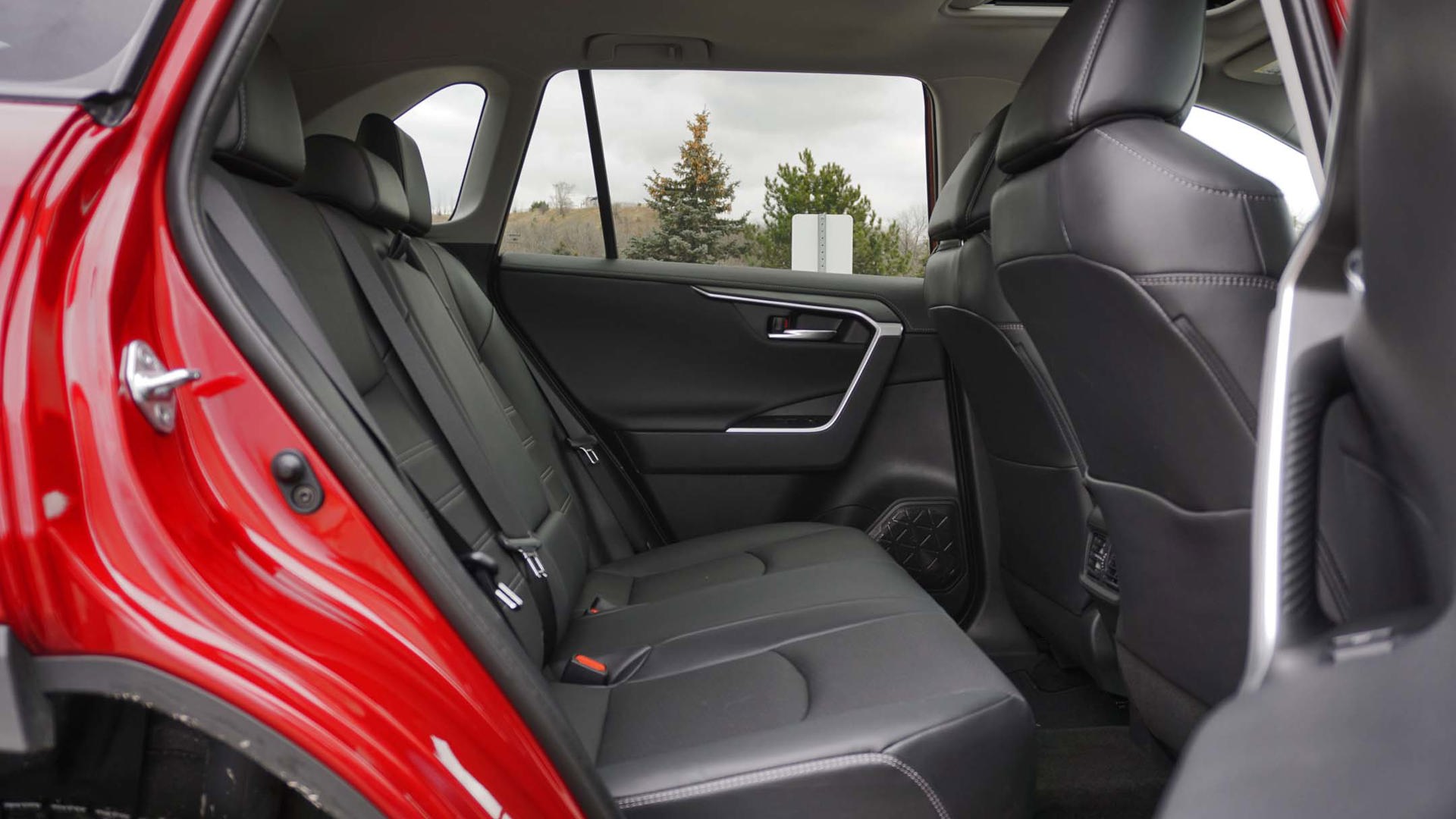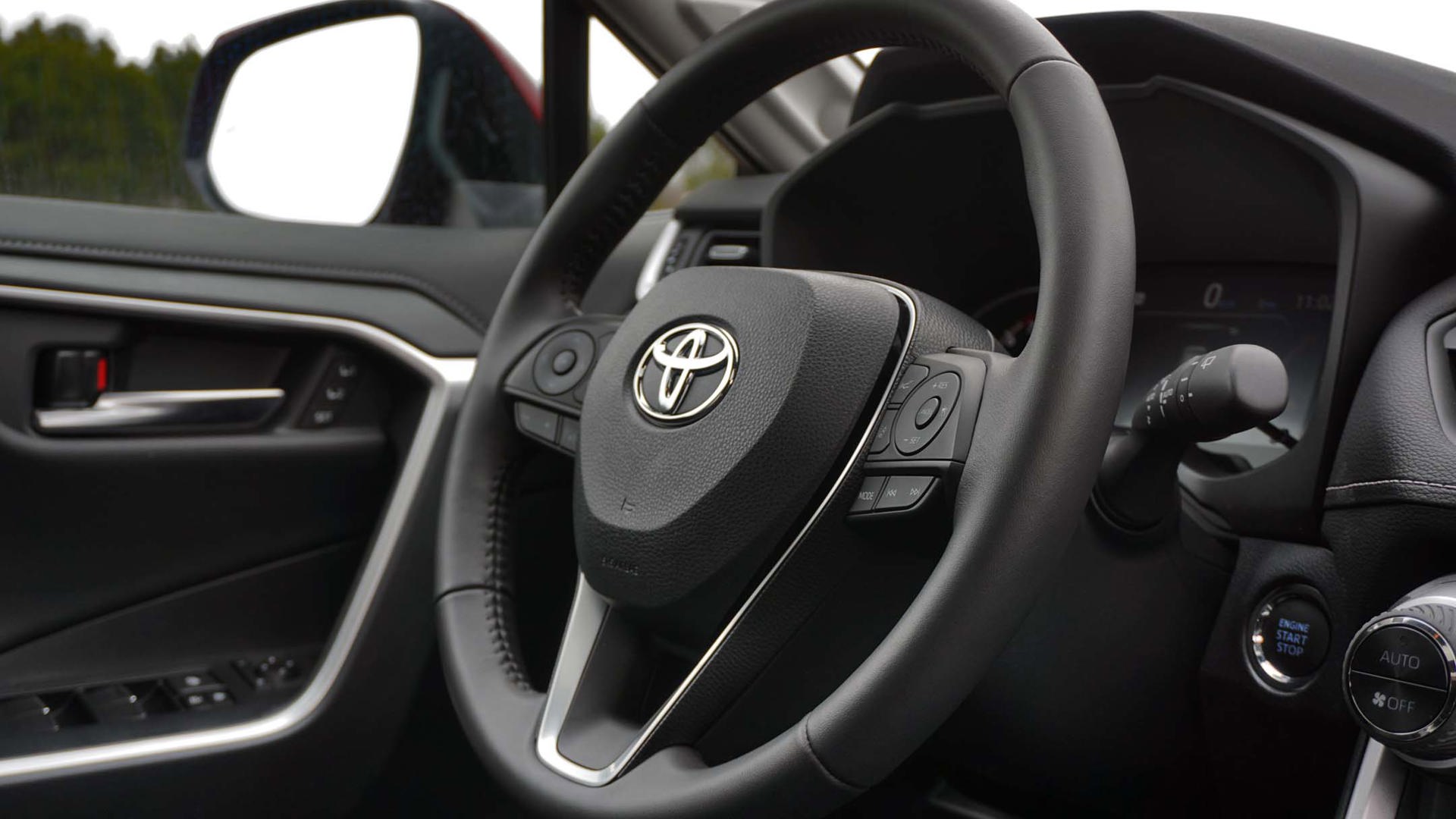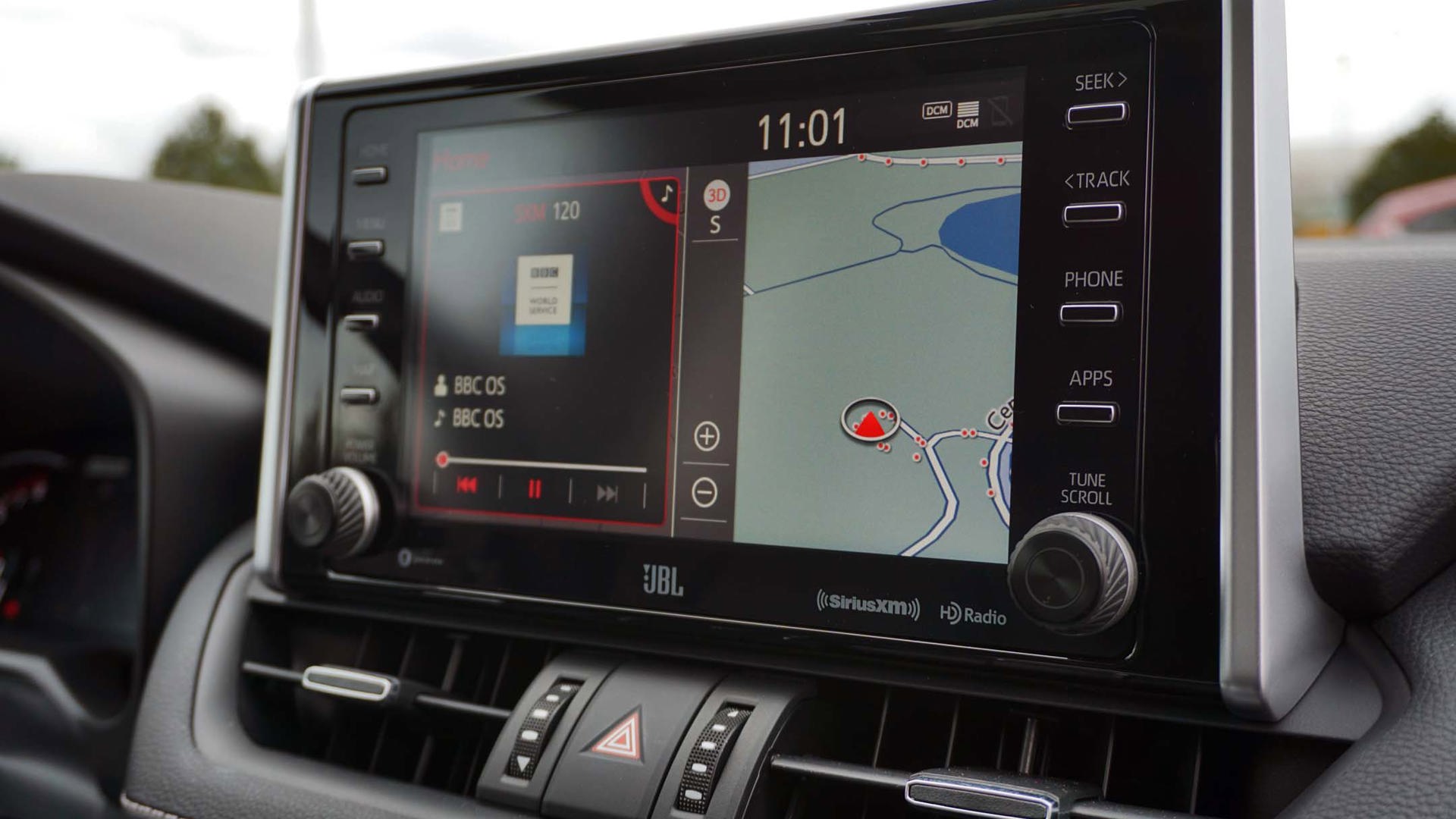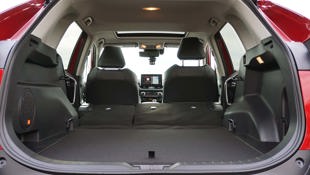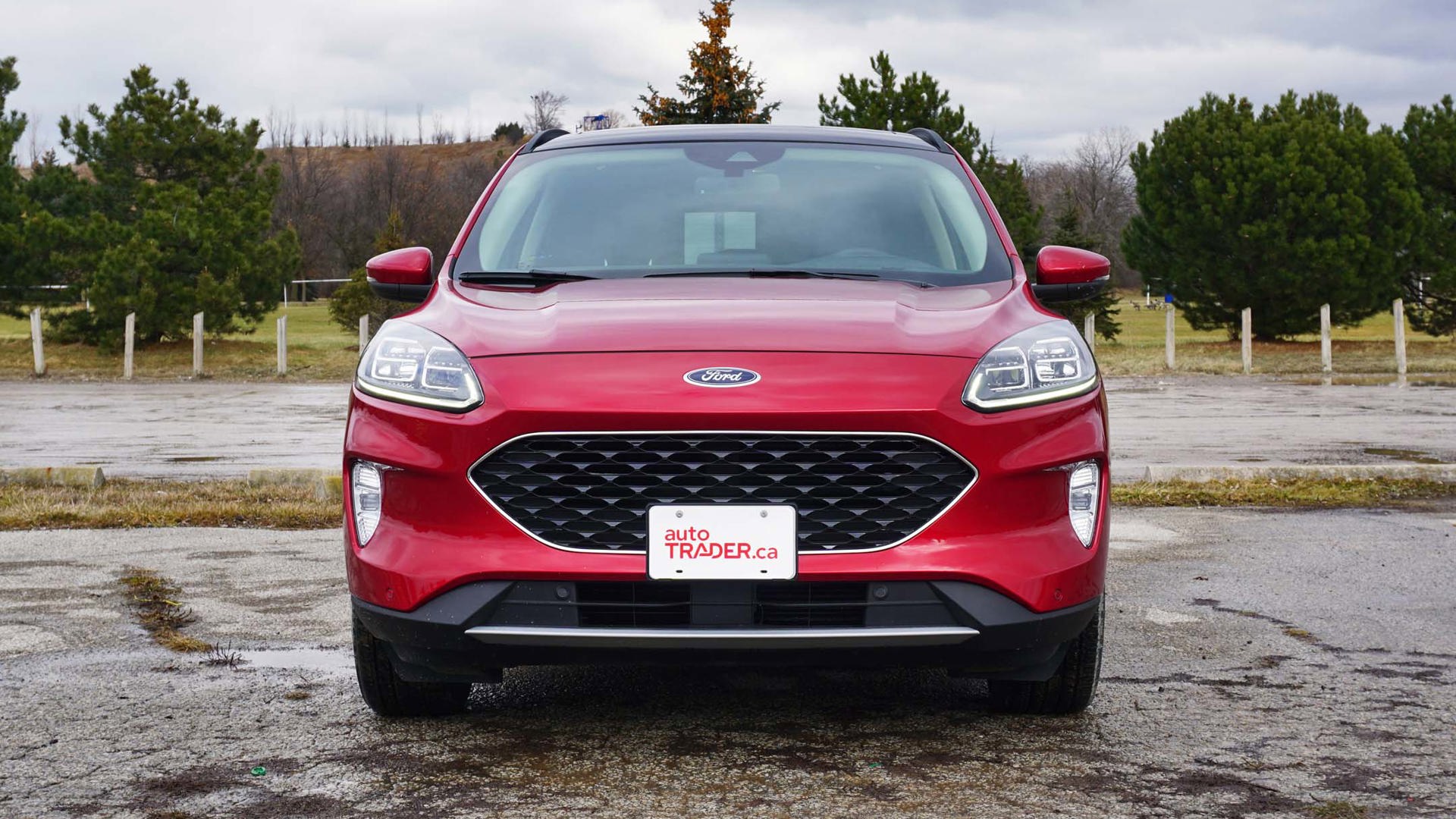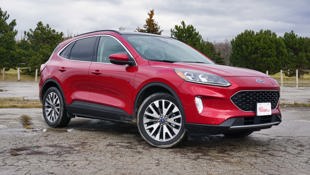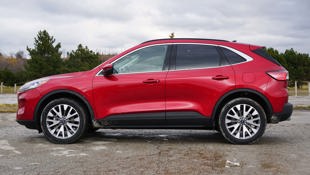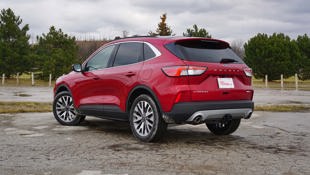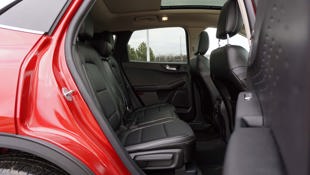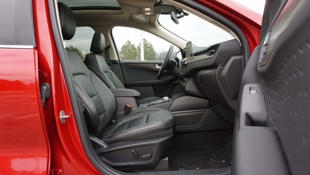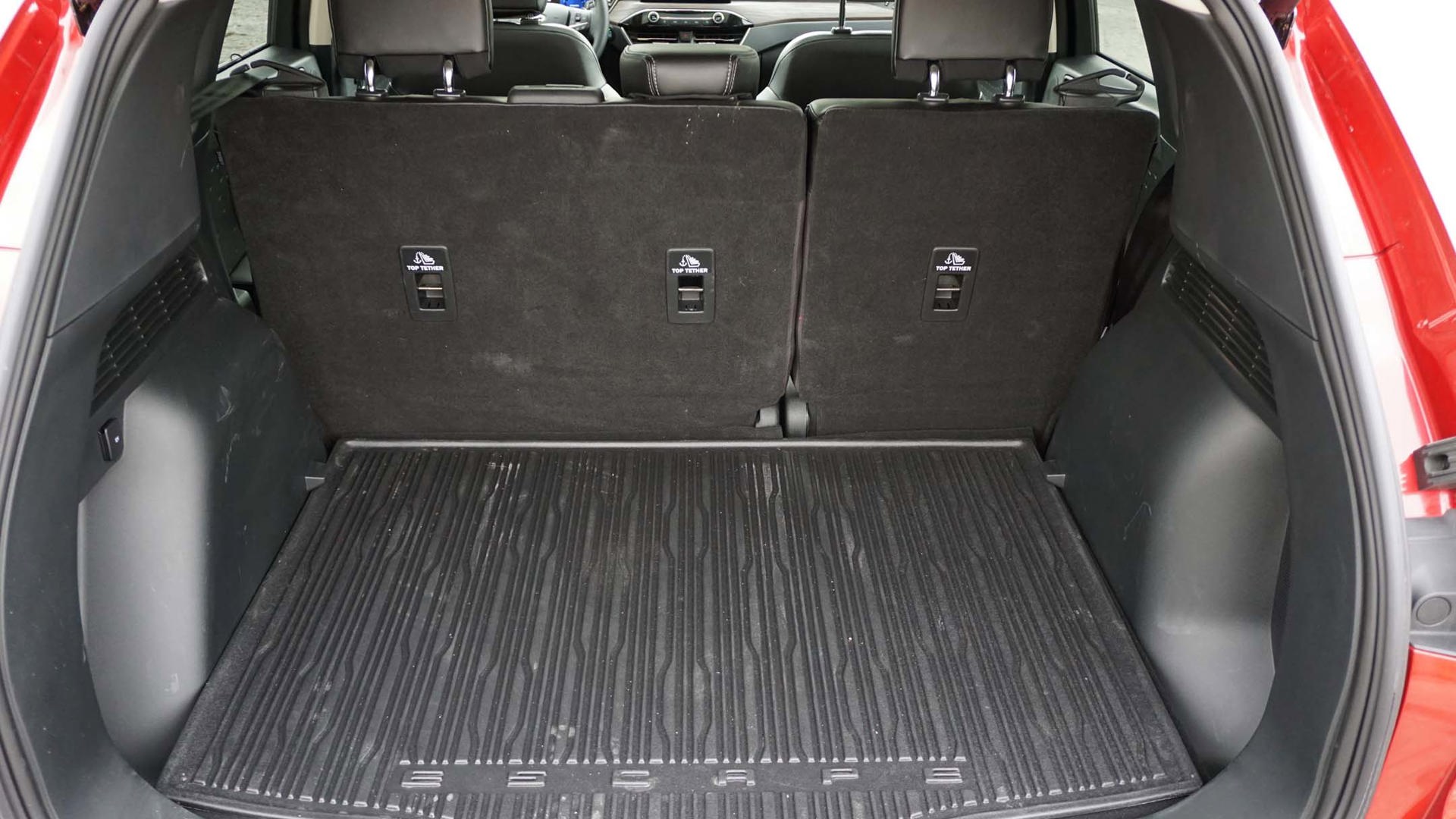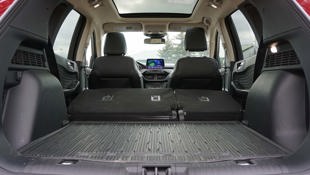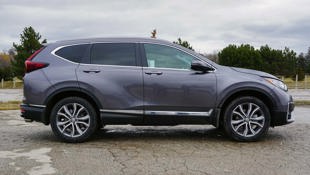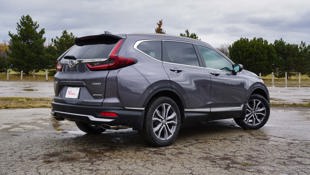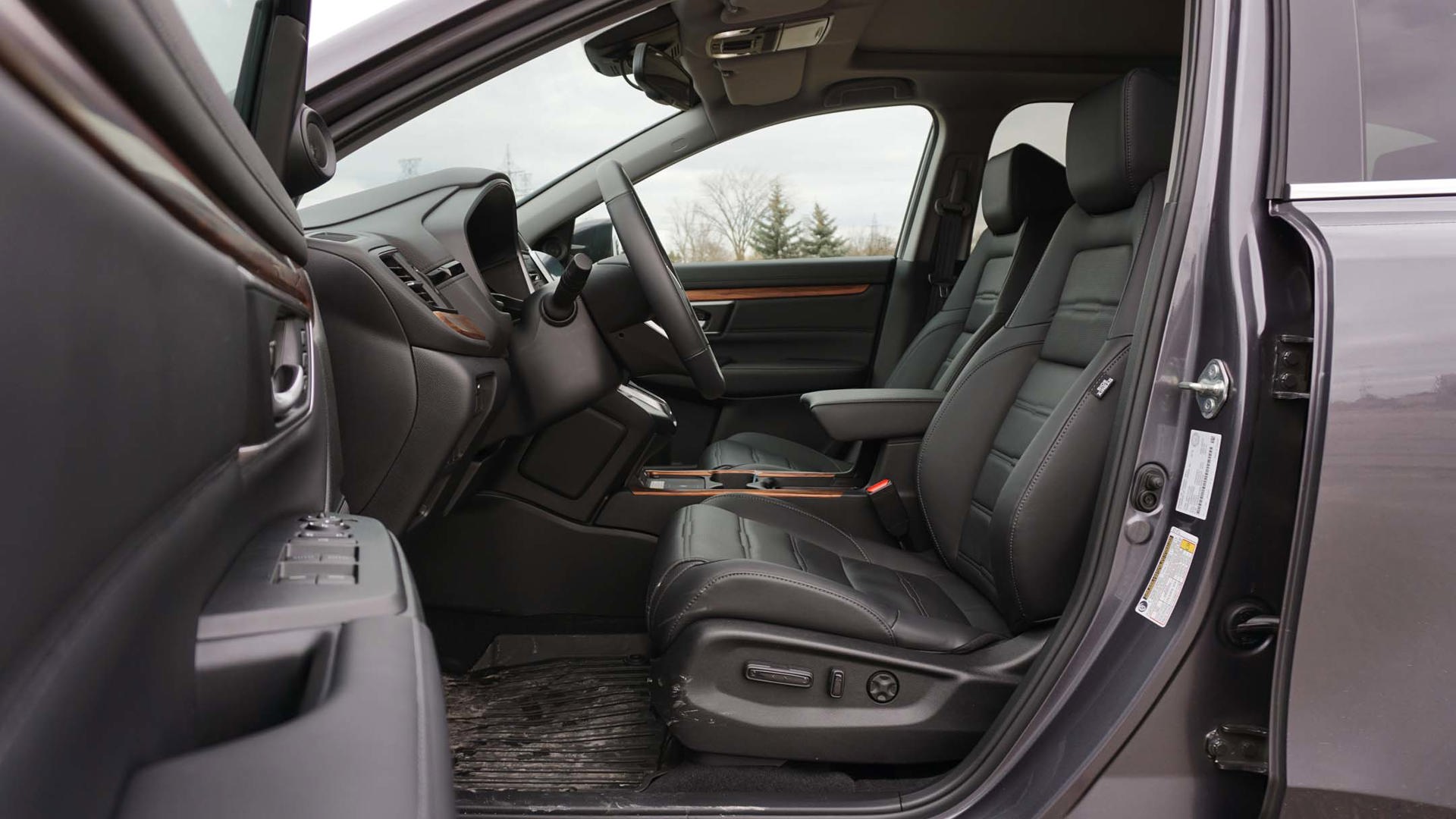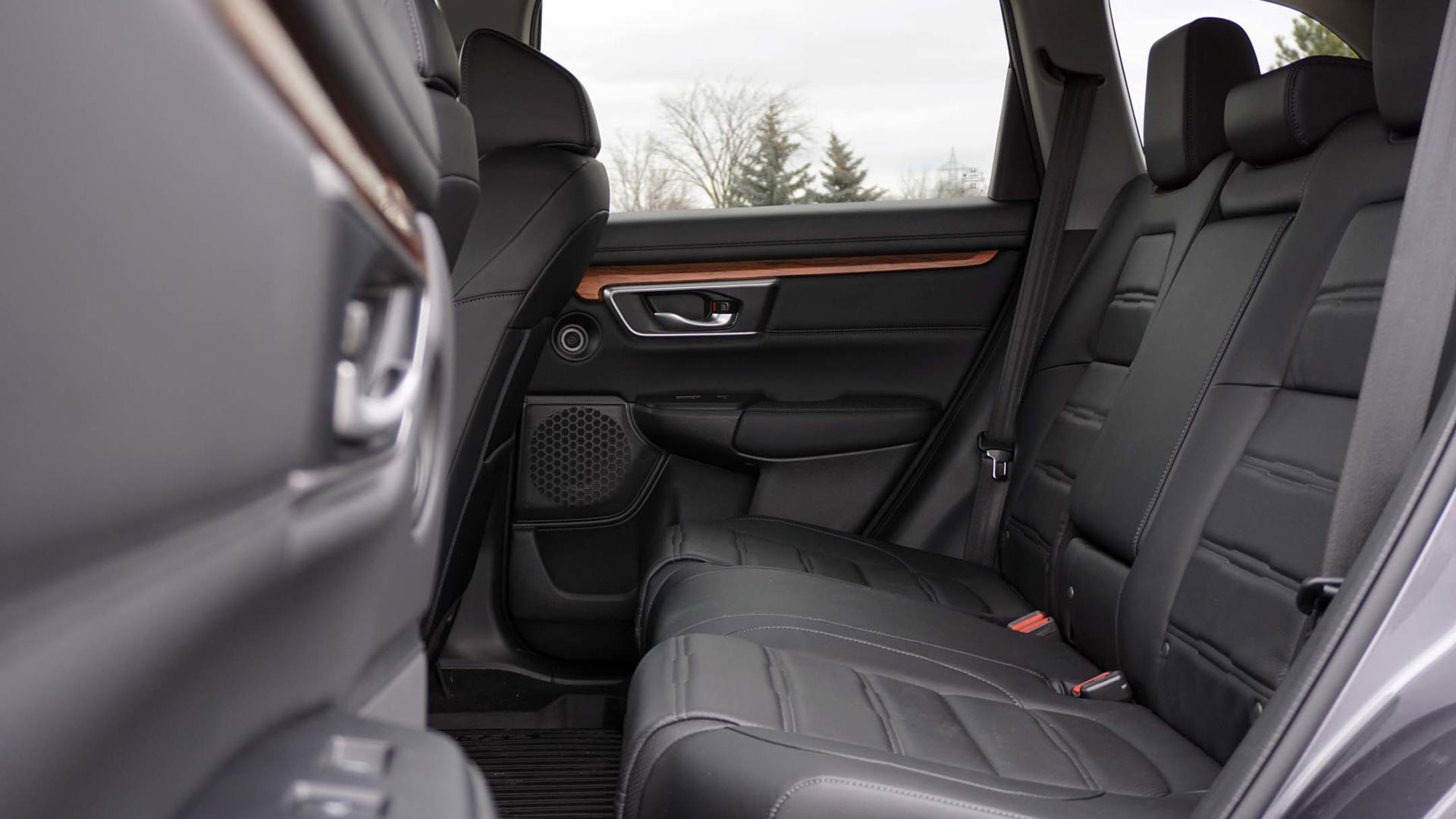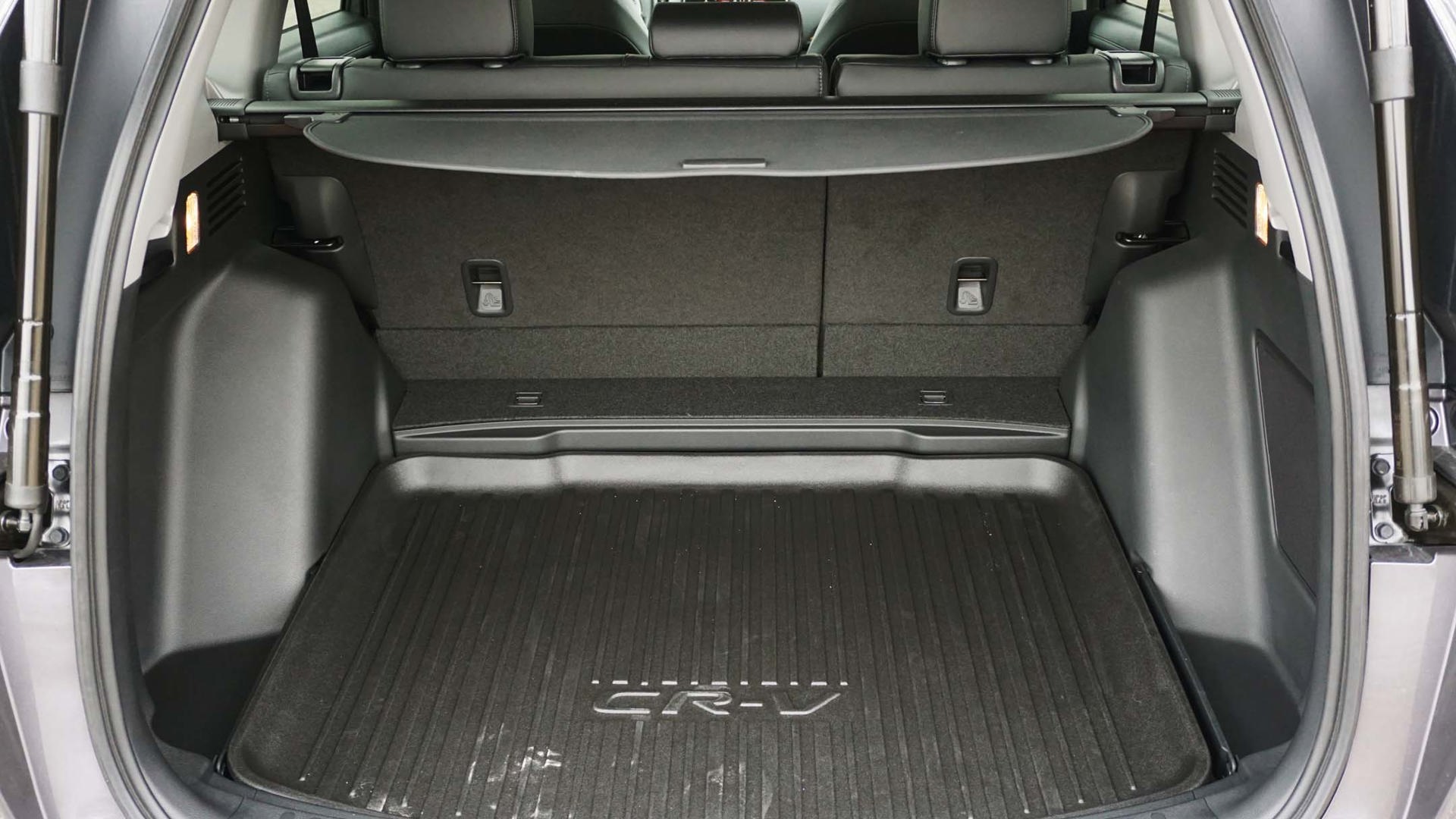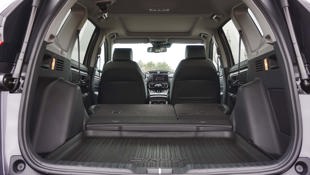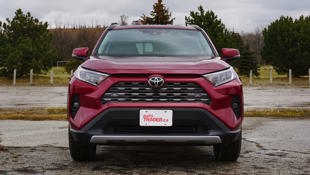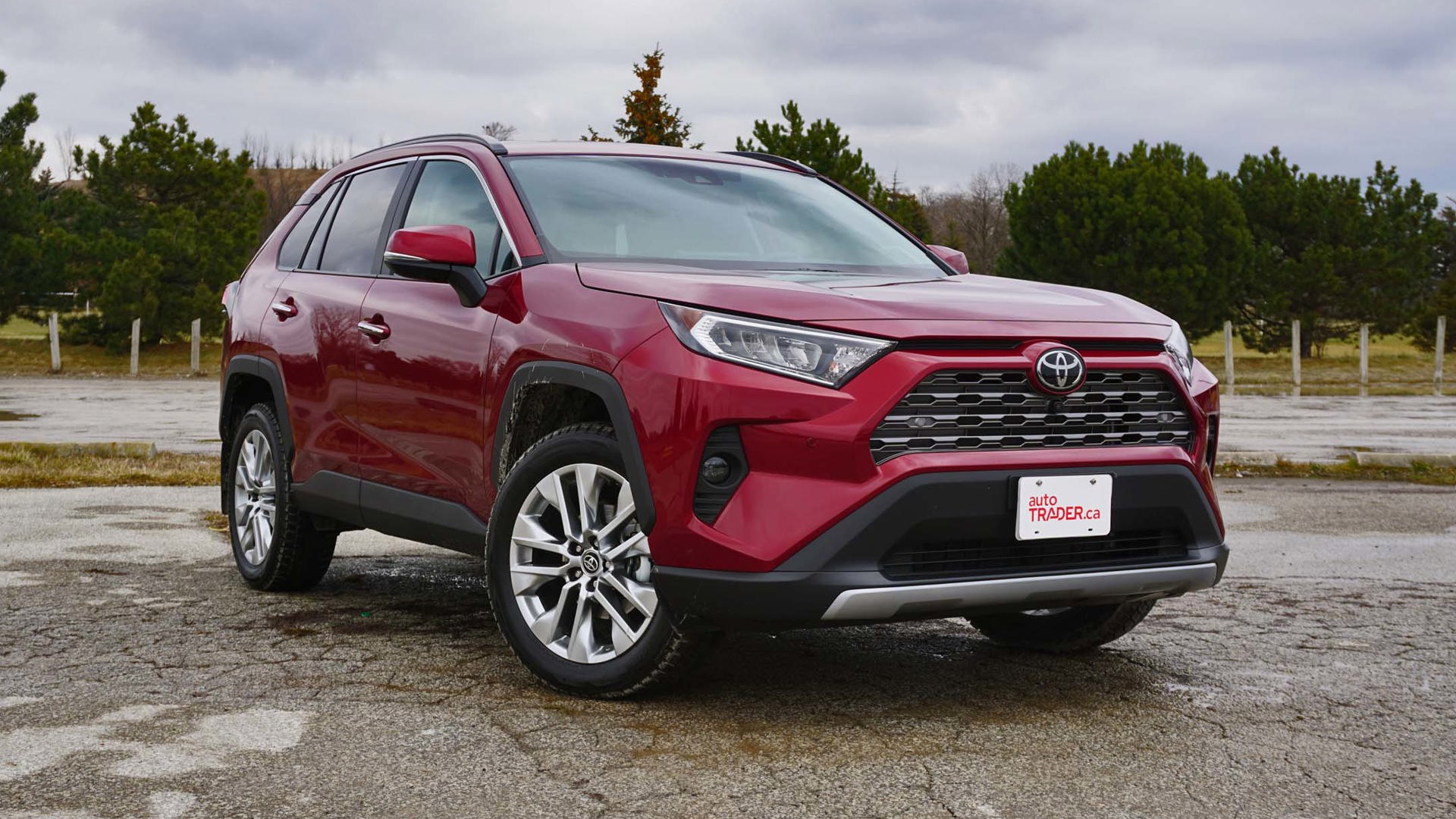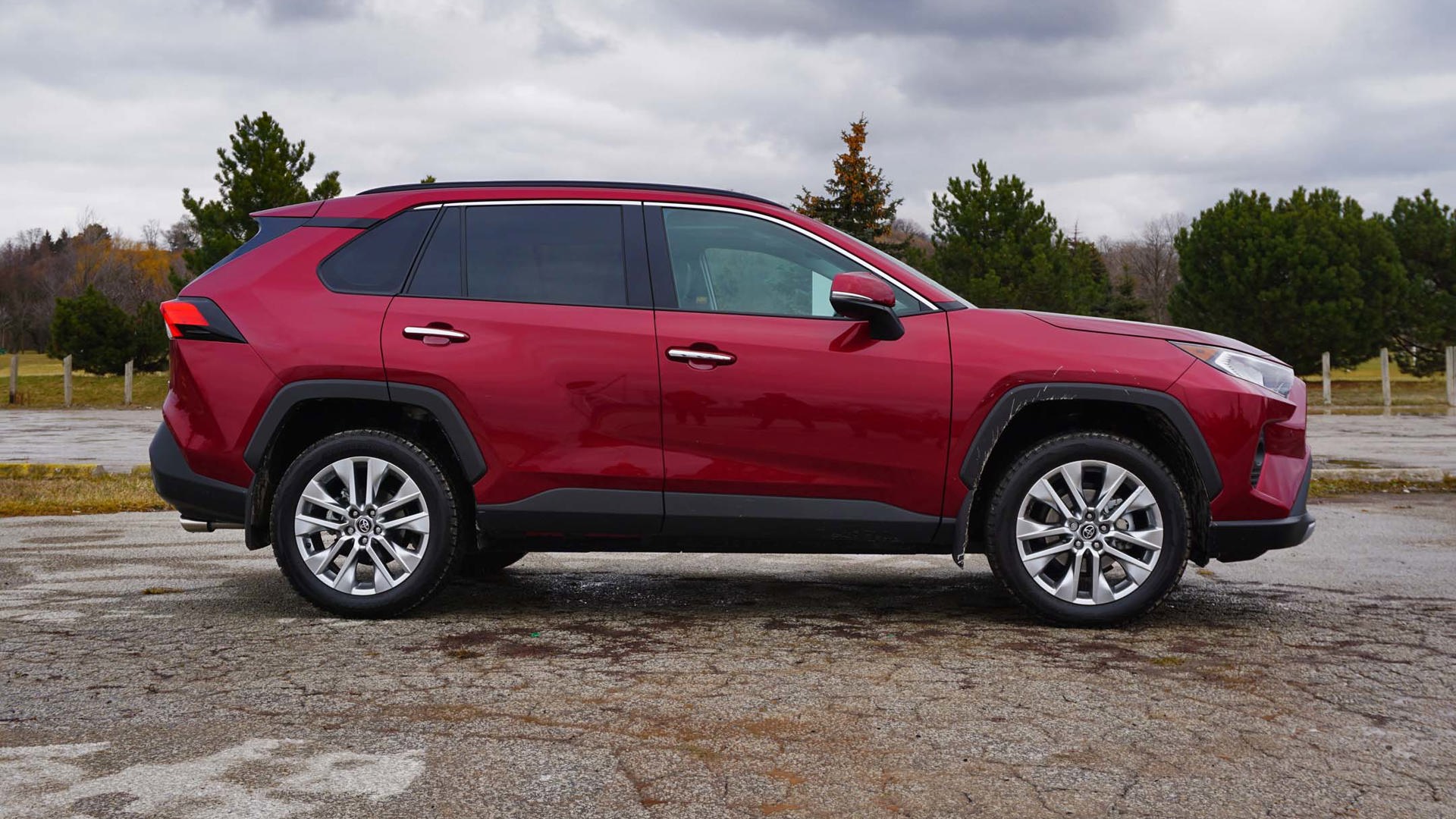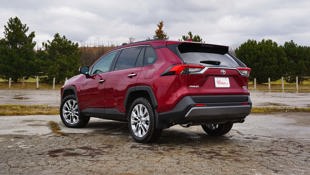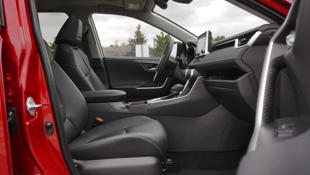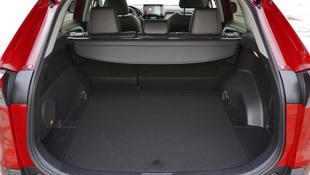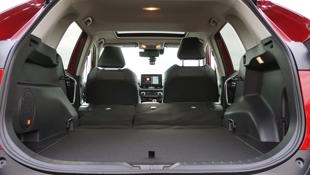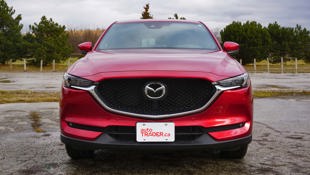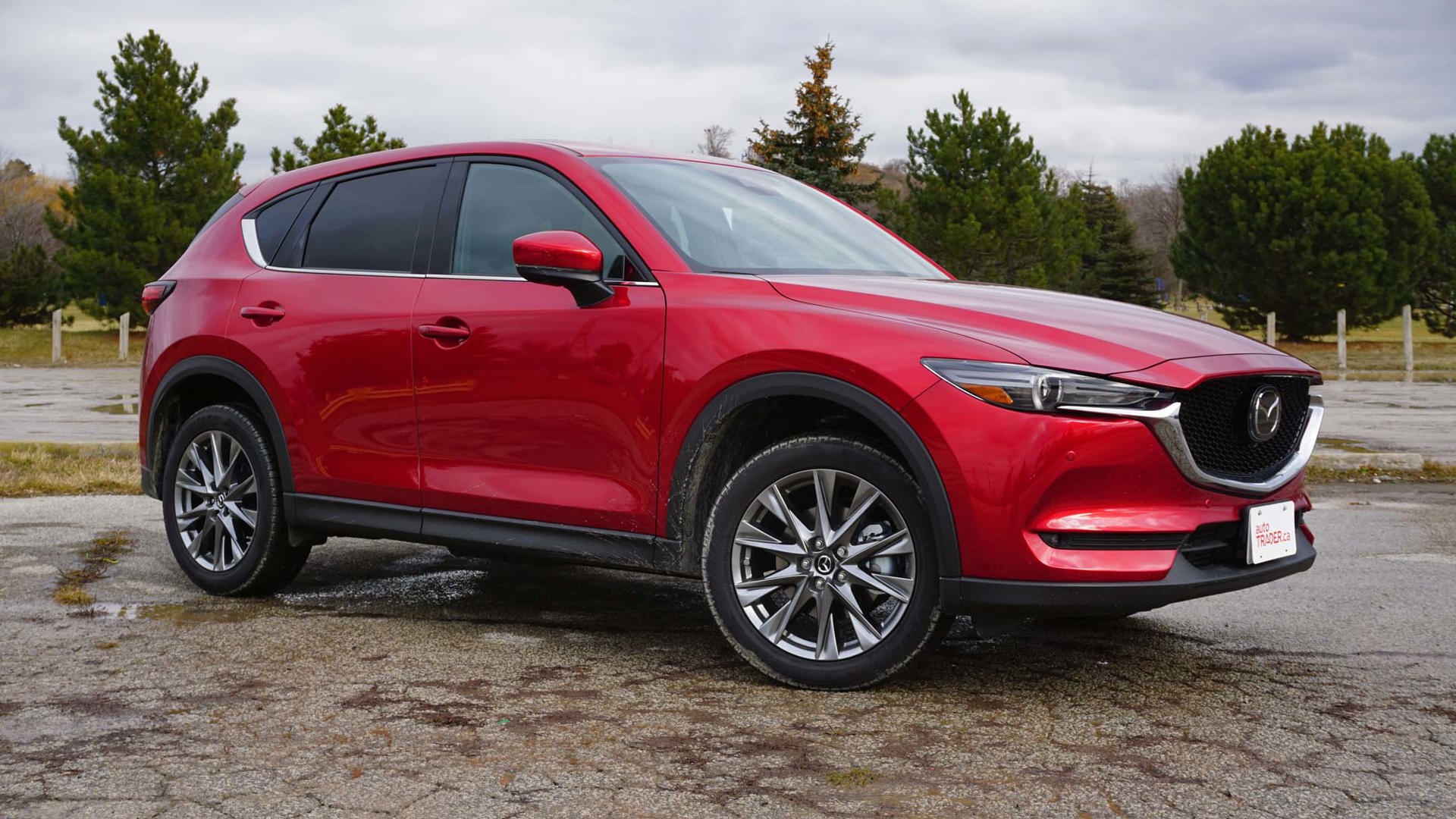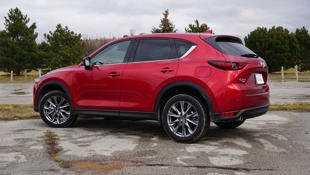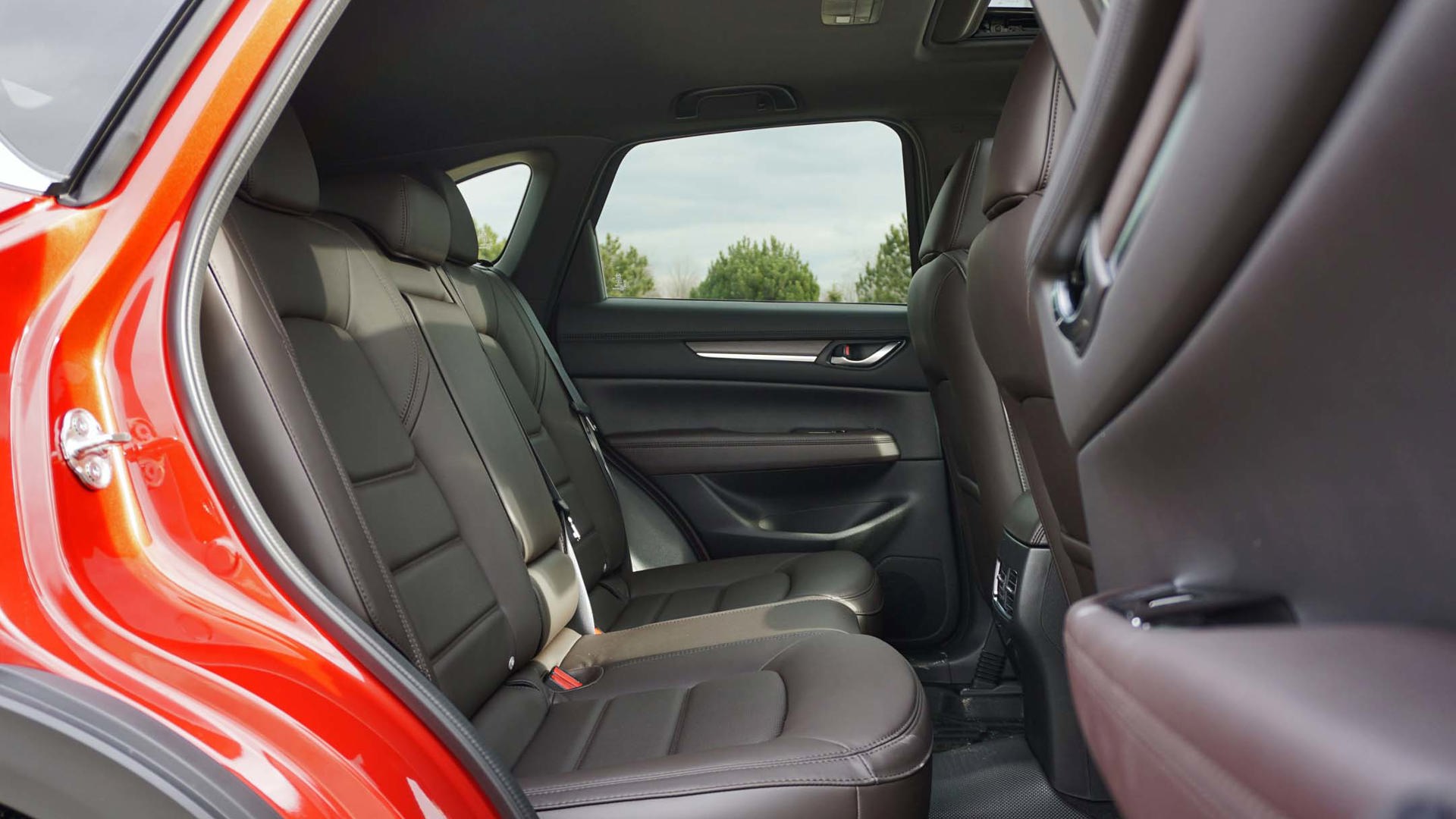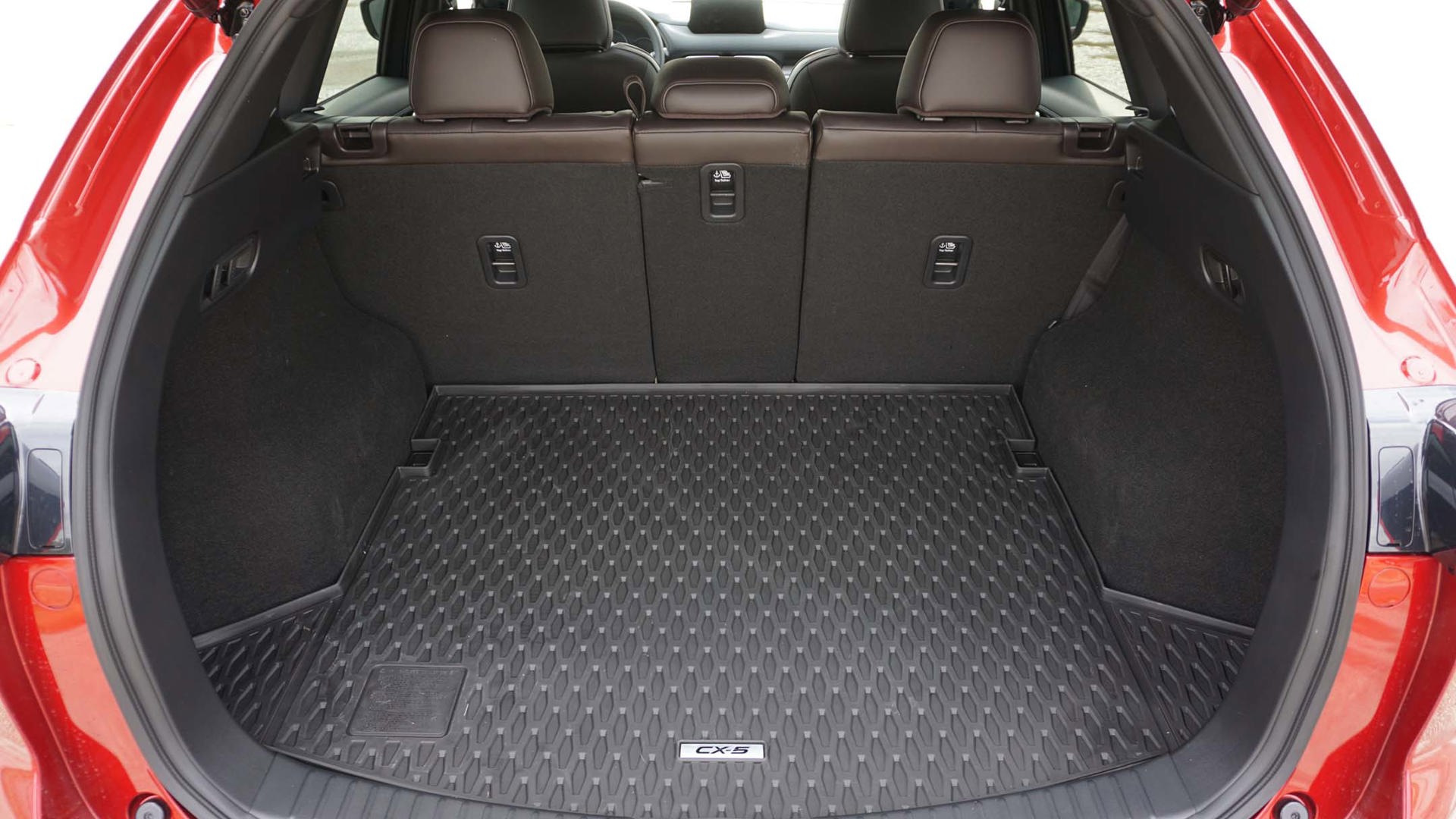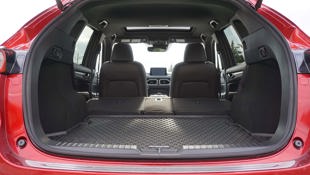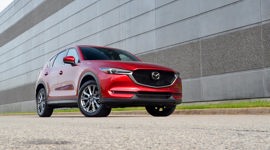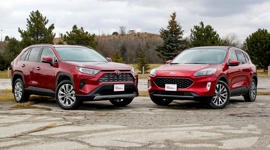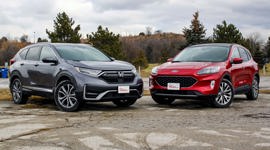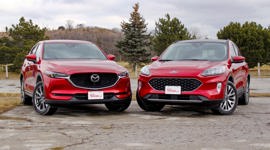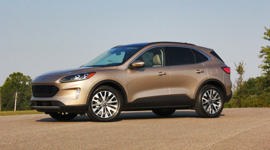Comparison Data
|
2020 Ford Escape Titanium
|
2020 Honda CR-V Touring
|
2020 Mazda CX-5 Signature
|
2020 Toyota RAV4 Limited
|
|---|---|---|---|
|
Engine Displacement
2.0L
|
1.5L
|
2.5L
|
2.5L
|
|
Engine Cylinders
Turbo I4
|
Turbo I4
|
Turbo I4
|
I4
|
|
Peak Horsepower
250 hp
|
190 hp
|
250 hp
|
203 hp
|
|
Peak Torque
280 lb-ft
|
179 lb-ft
|
320 lb-ft
|
184 lb-ft
|
|
Fuel Economy
10.4/7.5/9.1 L/100 km cty/hwy/cmb
|
8.7/7.4/8.1 L/100 km cty/hwy/cmb
|
10.8/8.7/9.8 L/100 km cty/hwy/cmb
|
9.2/7.1/8.2 L/100 km cty/hwy/cmb
|
|
Cargo Space
869 / 1,852 L seats down
|
1,110 / 2,150 L seats down
|
875 / 1,687 L seats down
|
1,059 / 1,977 L seats down
|
|
Base Price
$40,049
|
$41,090
|
$41,900
|
$41,505
|
|
A/C Tax
$100
|
$100
|
$100
|
$100
|
|
Destination Fee
$1,850
|
$1,815
|
$1,950
|
$1,840
|
|
Price as Tested
$44,749
|
$43,036
|
$44,749
|
$43,476
|
|
Optional Equipment
|
With so much emphasis on three-row SUVs these days, it’s easy to forget that their smaller siblings will easily satisfy the needs of most Canadians.
Unless you need space to shuttle more than four people with any frequency – in which case you should be shopping for a minivan – a small SUV will handle just about anything thrown its way with very few sacrifices. That’s especially true of the top-of-the-line trims, with some entries coming close to premium levels of comfort, quality, and refinement.
For this comparison, we’ve rounded up the latest and greatest versions of the Ford Escape, Honda CR-V, Toyota RAV4 – four of the best the segment has to offer. All sporting all-wheel drive and specced in their priciest packages, this quartet is certainly worth considering in such a highly competitive segment. But we don’t believe in participation trophies at autoTRADER.ca, and one must emerge victorious.
2020 Ford Escape Titanium
There’s not a vehicle in this comparison – and maybe even on the market as a whole – that has more to do than the latest installment of the Escape. Completely overhauled for the 2020 model year, the fourth-generation model bears the responsibility of being an improvement over the previous version while also filling holes in the Ford lineup left by the Focus and Fusion, both victims of the automaker’s withdrawal from the passenger car market in North America.
Unfortunately, that’s left it feeling somewhat compromised compared to other SUVs of its size; almost like it’s trying to be too many vehicles at once. Whereas the other automakers in this comparison test have well-rounded lineups that leave their small SUVS to be, well, small SUVs, the Escape is tasked with enticing Ford fans orphaned by the brand’s move away from cars not called Mustang.
That doesn’t mean the Escape is a bad vehicle – far from it, in fact. It’s just not as focussed as many of its competitors, including the three it’s up against here. That’s especially true when comparing their abilities to carry cargo. While the Escape boasts a bit more capacity than the CX-5 with the back seats folded, the 1,852 L provided is well short of both the CR-V and RAV4. Cargo space behind the second row of seats stands at 869 L, which is about the same as what’s offered in the Mazda but significantly less than the Honda and Toyota (1,110 L and 1,059 L, respectively).
The Escape makes up a bit of ground with a second row that rides on rails, allowing the seats to be slid fore and aft to provide more room for stuff or people as necessary. However, the extra space afforded by the simple feature still falls short of the leading competitors while rendering the rear seats all but useless for anyone other than small children. For some added utility, the top Titanium trim we tested also gets Ford’s fancy foot-activated tailgate that allows for hands-free operation of the hatch; simply hold a foot beneath the back bumper for a brief second and voilà.
Thanks in part to the sliding second row, the Escape’s ability to accommodate passengers is almost as good as what’s offered by its top adversaries. While not quite as spacious as the CR-V and RAV4, there’s more than enough room in the cabin to accommodate four adults with ease. Of course, the front seats are the preferred place to be, with the power-adjustable units in the top-of-the-line model offering cozy accommodations to occupants of all sizes. The front seats are also heated, as is the steering wheel, features found in all the vehicles in this contest. It’s not perfect up front, however, with ventilation functionality notably absent – a feature that’s offered by both the RAV4 and CX-5. Likewise, the rear seats aren’t heated here despite being included in all three of the other vehicles in this competition.
Otherwise, it’s a well-featured cabin, with technology like Apple CarPlay and Android Auto connectivity, as well as a Wi-Fi hotspot. (Interestingly, that Wi-Fi connection is included on all Escape models but the iPhone and Android interfacing isn’t, making it the only vehicle in this comparison that doesn’t include the in-demand feature on all models.) This top trim also features a fully digital instrument cluster that can be configured to display different vehicle information, while an available head-up display projects drive-related info on a flimsy plastic panel that pops out of the dash.
Advanced safety features abound in the Escape Titanium, with adaptive cruise control that works in stop-and-go traffic operating as effectively as anything else on the market. Ditto the rest of the features in the Escape, with systems like lane-keep assist doing the job without the degree of panic found elsewhere in the competitive set. (Most advanced safety features are standard on all Escape models, though adaptive cruise control isn’t offered on the base trim.)
The Escape is one of the few mainstream models to feature a self-parking system, and it works flawlessly. Standard fare on the top trim, the system offers the ability to park in spots both perpendicular and parallel – as well as pull out of the latter – though it’s a little gimmicky and the team here at autoTRADER.ca is in agreement that we’d rather have ventilated seats than a self-parking feature.
In terms of the way it rides, the Escape isn’t the smoothest of the four crossovers gathered here, though it’s not uncomfortable either. There’s a bit of lateral rigidity that’s more common to body-on-frame vehicles than unibody ones, with the Escape seesawing over undulating asphalt. It’s a reasonably smooth affair otherwise, with a well-damped suspension and a cooperative demeanour that makes it as easy to drive as a vehicle in this segment should be.
The 2020 Escape is one of the few entries in the class to offer optional powertrains, with the choice between two turbocharged gas engines, a conventional hybrid, and an upcoming plug-in hybrid. The Titanium model tested here comes fitted with a 2.0L turbo four-cylinder that puts out some impressive numbers: 250 hp and 280 lb-ft of torque. That optimum output comes when burning premium fuel, but it’s worth the additional cost at the pumps for the way the Escape hustles around.
While it doesn’t feel quite as buttoned-down as the CX-5, the Escape is certainly about as quick, making passing manoeuvres as effortless as possible. While there’s some serious turbo lag – the full serving of torque doesn’t kick in until 3,000 rpm – and the eight-speed automatic suffers from the occasional hiccup, few small SUVs offer the type of performance found in the 2020 Escape Titanium. That’s also true of its ability to tow, with the 2.0L turbo-powered version rated to pull 3,500 lb – a segment-best number matched only by one specific RAV4 trim.
When it comes to value, the Ford falls right in line with the rest of the compact crossovers we gathered for this comparison. The Escape Titanium carries an MSRP of $40,049 – interestingly, the conventional hybrid version of the same trim is priced about $3,500 less – and only one option is offered: the $2,300 Premium Package that includes the head-up display and massive panoramic sunroof. Even with the optional red paint and winter-ready floor mats, the version we tested rang in at $45,049 with freight and fees. That’s a lot of dough, but it’s not far off of the other SUVs here.
2020 Honda CR-V Touring
There are plenty of reasons the CR-V has for years been the stick by which all small SUVs are measured. Providing an inspired drive, however, isn’t one of them. While that may seem like a slight against the segment-leading CR-V, it does so much else right that it makes the dull drive a worthwhile sacrifice for most Canadians.
A fully loaded Touring model is priced at $41,090 and has no options boxes to tick; what you see is what you get. Tacking on the requisite destination and eco taxes brings the final pre-tax price to $43,036, so right in line with the competition. Sure, it’s a couple grand cheaper than the Escape, but given the popularity of extended finance terms these days, those savings aren’t exactly enough to keep a buyer out of the CR-V – especially given what you’re getting in terms of outright roominess.
What that extra dough gets you is the most spacious entry in the segment by a good margin, with 1,110 L of cargo room behind the rear seats and a cavernous 2,150 L with them folded flat. The liftover height is also incredibly low, with a wagon-like load floor that will prevent a trip to the chiropractor the first time you toss a heavy suitcase in the back. The RAV4 doesn’t trail the CR-V by much in terms of the numbers, but peeking inside provides a different conclusion, with the popular Honda looking and feeling far bigger behind the tailgate – which, like the Escape, offers hands-free operation in its priciest trim.
Unlike the Escape, the CR-V’s second row doesn’t move, but that’s because it doesn’t have to. Beyond offering the most cargo room around, space in the rear seats is unmatched even by some larger SUVs. On paper, there’s 1,025 mm of legroom for backseat passengers, but in practice there’s the type of room that means a long-limbed occupant like yours truly can quite literally stretch out and feel comfortable in the second row. Better still, the CR-V’s rear doors open a full 90 degrees, which parents will no doubt appreciate when it comes time to load kids in car seats.
Oddly, all that space in the back isn’t matched by much roominess in the front of the cabin. Most occupants of average height are unlikely to be troubled by the severe slope of the windshield, but those on the taller side will find themselves putting the power-adjustable driver and passenger seats to work. Front-seat headroom isn’t the worst of the four small SUVs in the competition, but it’s close – and, somewhat surprisingly, falls short of even the CX-5. Long-legged drivers will also find the centre console a source of discomfort on lengthier drives, with the hard plastic it’s made of as unpleasant as it is unavoidable when sitting behind the wheel. Your right knee has been warned.
Limited space aside, settling into the driver’s seat is as uncomplicated as any of the other crossovers in this comparison, with the CR-V featuring a logical layout of almost all the switchgear inside. It’s among the most approachable on the market in terms of its simplicity, with virtually no learning curve to any of the controls or systems. That is, of course, until it comes to the infotainment system.
While the layout of the home screen gives the appearance of user-friendliness, the laggy operation is quick to prove otherwise, leading to plenty of headaches when switching from one page to the next or inputting directions into the integrated navigation system included on the top-of-the-line Touring model. Our best advice: Avoid interacting with the interface and stick to the standard Apple CarPlay and Android Auto compatibility to mirror the functionality of your smartphone.
Features in the CR-V begin and end with the on-board Wi-Fi hotspot, joining the Escape as the only two with the road-trip-friendly feature. There’s not much here otherwise, and just like the Ford, the top trim does not include ventilated front seats. Both rows of seats are heated, however, as is the steering wheel. While those leather-adorned items are nice to the touch, the same can’t be said about much else inside, with cheap materials that betray the overall quality of the CR-V. That’s especially true of the plastic trim pieces painted to look like wood in the Touring trim, something that’s present elsewhere in this comparison but stands out here for all the wrong reasons.
The CR-V is the only vehicle in this comparison to offer just one powertrain: a 1.5L turbocharged four-cylinder mated to a continuously variable transmission (CVT). While engine output is adequate – 190 hp; 179 lb-ft of torque – the pairing is something of a weak spot. Whether at idle or under acceleration, the 1.5L is loud and clattery, while the transmission drones under heavy acceleration. SUVs like these aren’t meant to be fast, so the fact the CR-V won’t turn heads off the line isn’t a problem. What is, however, is the sluggish way in which the CR-V takes care of merging and passing. With no way to shift gears yourself, and no selectable drive modes to dial up the throttle response, the CR-V is often caught flat-footed at inopportune times, particularly when it comes time to pass slower traffic at highway speeds.
The engine/transmission combo also can’t do much when it comes to towing, with the CR-V rated to pull just 1,500 lb. While that’s the same as what’s offered by other small SUVs, including the RAV4 tested here, it’s well short of the Escape and less than the 2,000 lb the CX-5 can pull.
Where the segment stalwart earns its keep in terms of its powertrain is at the pumps. Not only does it run on regular-grade gasoline, but the CR-V is the most efficient of all the SUVs here. Natural Resources Canada (NRCan) rates the Honda at 8.7 L/100 km in the city, 7.2 L/100 km on the highway, and 8.0 L/100 km combined. That’s far better than the Escape (11.5/8.7/10.2) and CX-5 (10.8/8.7/9.8) models brought together for this comparison, and is especially significant considering premium gas is recommended in both. The RAV4 isn’t far off the CR-V, with ratings of 9.2 L/100 km around town, 7.1 L/100 km on the highway and 8.3 L/100 km combined, but the CR-V consistently topped the Toyota during our time with both.
When it comes to ride and handling, well, the CR-V is about as underwhelming as anything else on the market. However, it’s nearly as comfortable as the other crossovers in this comparison, with the multi-link rear suspension tuned to do its job effectively. Otherwise, it’s an uninspired affair, without much in the way of steering feel or feedback. While that numbness will suit most folks just fine, the team here at autoTRADER.ca likes a bit more communication about what’s going on while we drive.
A robust advanced safety system is standard on all CR-V models, with everything from adaptive cruise control, lane-keep assist, automatic emergency braking, and automatic high-beams featured here. In fact, it’s only blind-spot monitoring that’s held off the spec sheet for all models, with all but base models featuring Honda’s camera-based system for the passenger side and the top trim getting blind-spot sensors.
2020 Toyota RAV4 Limited
Most – though not all – of what’s been written about the CR-V could also cover the RAV4. Both Ontario-built SUVs have been at the top of the Canadian sales charts for years, often swapping spots as the best-selling sport utility on the market (for the record, it was the RAV4 that took the crown in 2019).
So what else do these two popular people-movers have in common? Just like the CR-V, the RAV4 offers a ton of room inside for your stuff – 1,059 L behind the back seats, and 1,977 L with them stowed in the floor. It’s a big and boxy space, providing plenty of room to accommodate all kinds of items without the need to get creative. The same goes for the second row of seats, with lots of room for passengers get comfortable without contortion. But much like in the Honda, the RAV4 features a tall seating position and shallow slope to the windshield, combining with the sunroof that’s standard on the Limited trim tested here – and all but base models – to make the space up front unpleasant for taller occupants.
The RAV4 hits back with all the comfort features you’d expect in the segment, with heated rear seats and a heated steering wheel to go along with front seats that are heated and ventilated, exactly like the package in the CX-5. Unfortunately, that’s the end of the good news when it comes to the RAV4’s seats, with Toyota’s synthetic leather upholstery feeling at least a few notches below the competition in terms of quality.
The touchscreen infotainment system in the top grade is as big or bigger than anything else here, measuring an adequate eight inches. The industry trend of slapping the screen on top of the centre stack persists here, and it’s about as bad as it gets in terms of operation. Buttons that run along either side of the screen provide access to all kinds of functions and features, but the system itself is as clumsy and slow as what’s offered in the CR-V. Graciously, Apple CarPlay and Android Auto are here to save the day too, with the smartphone mirroring systems operating with far less frustration.
The cabin as a whole isn’t particularly attractive, and there’s nothing about the top-of-the-line trim in terms of the way it looks and feels that sets it apart from a base $28,000 version. Considering the loaded-up Limited model we tested rang in at $43,476 with freight and fees, it’s reasonable to expect a space that shows off the $25,000 price premium as soon as you climb inside.
While the Escape and CX-5 feature sleek exterior styling that’s more car than crossover and the CR-V looks, um, interesting, the RAV4 boasts a seriously rugged look. That’s especially true of the off-road-inspired Trail trim, but the overall aesthetic is chiselled and chunky, helping the RAV4 stand out from just about every one of its competitors.
The RAV4 also stands out from the competition when it comes to powertrain choice. While not quite as diverse as what’s offered in the Escape, the Toyota can be had with the choice of either a gas engine alone or a hybrid setup that adds an electric motor and a battery pack, with a plug-in hybrid on its way too. The tester Toyota provided for this sport utility shootout features the gas engine that provides adequate but somewhat uneven performance.
The only non-turbo motor in the comparison, the 2.5L makes 203 hp and 184 lb-ft – numbers that are marginally better than the CR-V’s and are delivered in a similar manner. Since it’s naturally aspirated, the four-cylinder doles out torque much more progressively, though it’s a buzzy affair as it works to accelerate quickly. The torque is routed to the wheels via an eight-speed automatic transmission, but it may as well be a CVT given the way it operates, delivering inconsistent acceleration and droning heavily while it tries to sort out what it wants to do.
Ride and handling are on par for the segment, doing the job just fine but without much of anything to stand out. Like the CR-V, it’s approachable and easy to operate – important traits to be sure, but the same can be said of the Escape and CX-5, yet they manage to inject some character into the drive.
2020 Mazda CX-5 Signature
Which, of course, brings us to our final contender – the CX-5. Of the four crossovers we rounded up for this comparison, the top-selling model in Mazda’s lineup might be the toughest to nail down. It’s easily the best driving of them all (and, indeed, in the segment as a whole), and probably feels the most premium and refined. But those characteristics don’t exactly make it great at being an SUV, standing in stark contrast to the RAV4 and CR-V in that regard.
There’s a reason Mazda has long been a favourite amongst automotive media types in Canada and elsewhere: The brand builds driver-focussed vehicles, and most of the people that make up this business like to drive. But we here at autoTRADER.ca look at what makes a great vehicle with far more objectivity; we know what appeals to a very specific subset of car-buyers – a prioritized drive experience – doesn’t do the same for the average Canadian. That’s especially true of small SUVs, with their versatility coming ahead of driving pleasure for the vast majority of buyers.
In that way, the CX-5 comes up well short of its adversaries. It’s not much smaller than the rest when it comes to its footprint, with the Mazda measuring 4,550 mm from bumper to bumper – less than 50 mm shorter than the RAV4. Unfortunately, it’s most noticeable when it comes to carrying cargo, with 875 L behind the back seats and 1,687 L with them folded away. That space is adequate for most jobs – groceries, garage sale finds, back-to-school shopping and the like – but could pose a problem when it comes time to take that family road trip or haul around a couple of hockey bags.
Where Mazda made the most of the space inside is in the passenger area. While the second row isn’t as roomy as the other three SUVs here, the front seats offer more comfortable accommodations for taller folks than those in the CR-V and RAV4. Just like the Escape, headroom in the CX-5 is surprisingly generous without the seating position feeling any lower than the competition. The Signature trim also boasts the same heated and ventilated front seats found in the Toyota – part of Mazda’s move into the void between the mainstream and premium markets.
While there’s not much in the way of trendy tech – no Wi-Fi hotspot, for example – the cabin feels almost as good as some upmarket offerings. Hide the Mazda badges inside and you’d manage to trick at least a few friends into thinking you shelled out for something from Infiniti or Audi – it’s that good inside. A nice mix of materials, including some of the best leather on the market, combines with a clean aesthetic to bolster the premium feel inside and provide the type of character the others in this contest can’t match.
The only shortcoming inside is the infotainment interface, which is clunky to operate and lacks any sort of aesthetic appeal. While Mazda has finally embraced the use of touchscreens in its vehicles, its safety-first approach renders the eight-inch capacitive display inactive when the vehicle is in motion. That means using the console-mounted rotary dial to navigate from one function to the next. Safety is paramount at autoTRADER.ca, but using the rotary dial is arguably a bigger distraction than tapping the dash-mounted touchscreen given its awkward position behind the gear selector.
Making matters worse, the infotainment system itself is outdated in both form and function, coming up short of even the RAV4 when it comes to graphics quality and responsiveness. Fortunately, Mazda has added Apple CarPlay and Android Auto for trouble-free phone pairing. The theme of sticking to either smartphone interface rather than the problem-plagued infotainment system continues here.
Where the CX-5 earns its keep in this competition and beyond is purely mechanical – and that’s especially true of this turbocharged Signature trim. Whereas the Escape errs on the stiff side in its ride quality, the CX-5 blends rigidity and compliance to perfection. If you’re after a small SUV that puts an emphasis on the drive then your search should begin and end here. Of course, that’s not the case for most shoppers in this segment, and admittedly, the Mazda fills something of a niche.
Adding to the goodness of what’s going on beneath the sheet metal is the sensational turbocharged 2.5L that’s standard in the Signature model (it’s also offered as a $2,000 upgrade in the GT version). Generating 250 hp on 93-octane gas or 227 hp on regular, the CX-5 is up there with the Escape when it comes to power. Torque, however, is a different story, with the Mazda making a healthy 320 lb-ft on premium gas and 310 lb-ft on the cheaper stuff. Not only is that output unmatched in the segment, but it kicks in at just 2,000 rpm, which means less waiting around for the party trick to happen.
Paired with a deft six-speed automatic, the CX-5 gets the torque down in a hurry, making quick work of merging or passing on the highway. But beyond just being quick in a straight line, the CX-5 is almost playful in its driving dynamics, with solid steering feel and a strong suspension damping that can occasionally make you forget that you are, in fact, driving a compact crossover and not an overgrown hatchback. That’s part of the DNA of any Mazda on the market today – genetics that are shared with even the MX-5 roadster. Yet the CX-5 also includes the family-friendly character necessary of an SUV (even if cargo room is lacking).
There’s also tons of safety stuff in the CX-5, but it’s not all standard the way it is in the CR-V and RAV4. The full suite does come in the second trim and up, which means everything up to and including adaptive cruise control that works in stop-and-go traffic is featured in the majority of new CX-5s out there, including the Signature model tested here. The advanced technology also works with less fuss than some of the other SUVs in this comparison, with the sensitivity of the various sensors not quite as touchy as those in the RAV4, for example.
With the only options offered on the CX-5 Signature being a trio of metallic paint choices, the top-of-the-line small SUV from Mazda falls in line with its competitors – $44,000 with freight and fees, when it comes to our Soul Red tester.
The Verdict
The team of four tasked with evaluating these full-featured family haulers was faced with a tougher task than any of us could have imagined. There were a few surprises after the numbers were tallied, but how close the final scores were proves just how competitive this segment has become in recent years.
The Ford Escape Titanium is best described as a jack of all trades but a master of none; a crossover that’s not without compromise, though it still manages to do a lot right. Then there’s the Honda CR-V Touring, a dull driver but one with the kind of space usually reserved for larger – and pricier SUVs – out there. The same is true of the Toyota RAV4 Limited, with a lack of anything that really sets it apart aside from space, but there’s lots of it. And then there’s the Mazda CX-5 Signature, a small sport utility that emphasizes the drive but sacrifices space along the way.
Ultimately, it was the Escape that impressed us most, earning the victory thanks to its ability to do most things well rather than any one thing wonderfully. It’s not without sacrifice – namely that it’s trying to be a catch-all for Ford – but that’s not necessarily an issue when compared to the other SUVs here. While the CR-V and RAV4 are great for carting around people and their stuff, they are soulless to drive and don’t do much to inspire. Conversely, the CX-5 is outstanding to drive but isn’t great at the fundamentals of what an SUV should be. The Ford, meanwhile, manages to blend both sides, providing an enjoyable enough drive without giving up too much in the way of utility.

